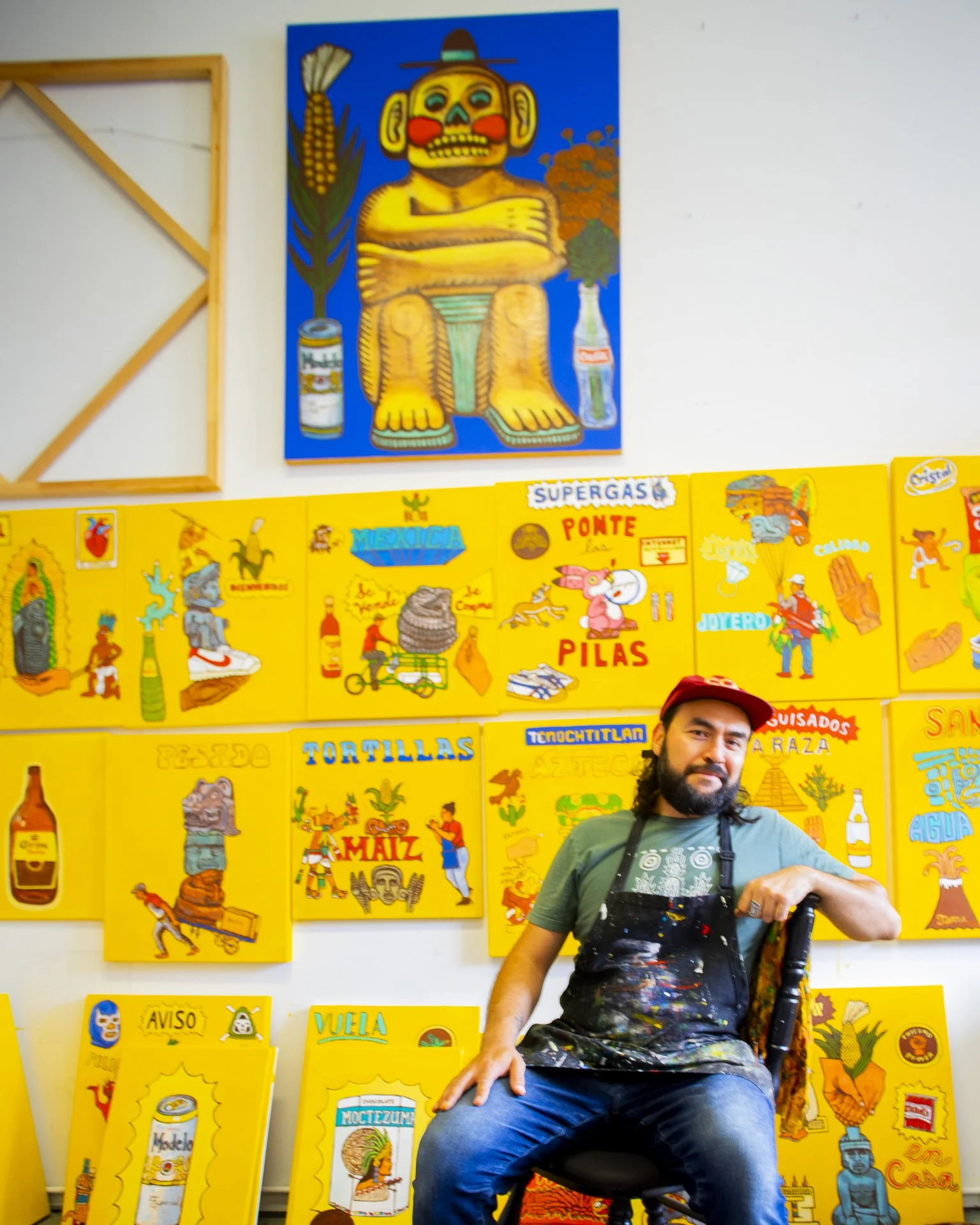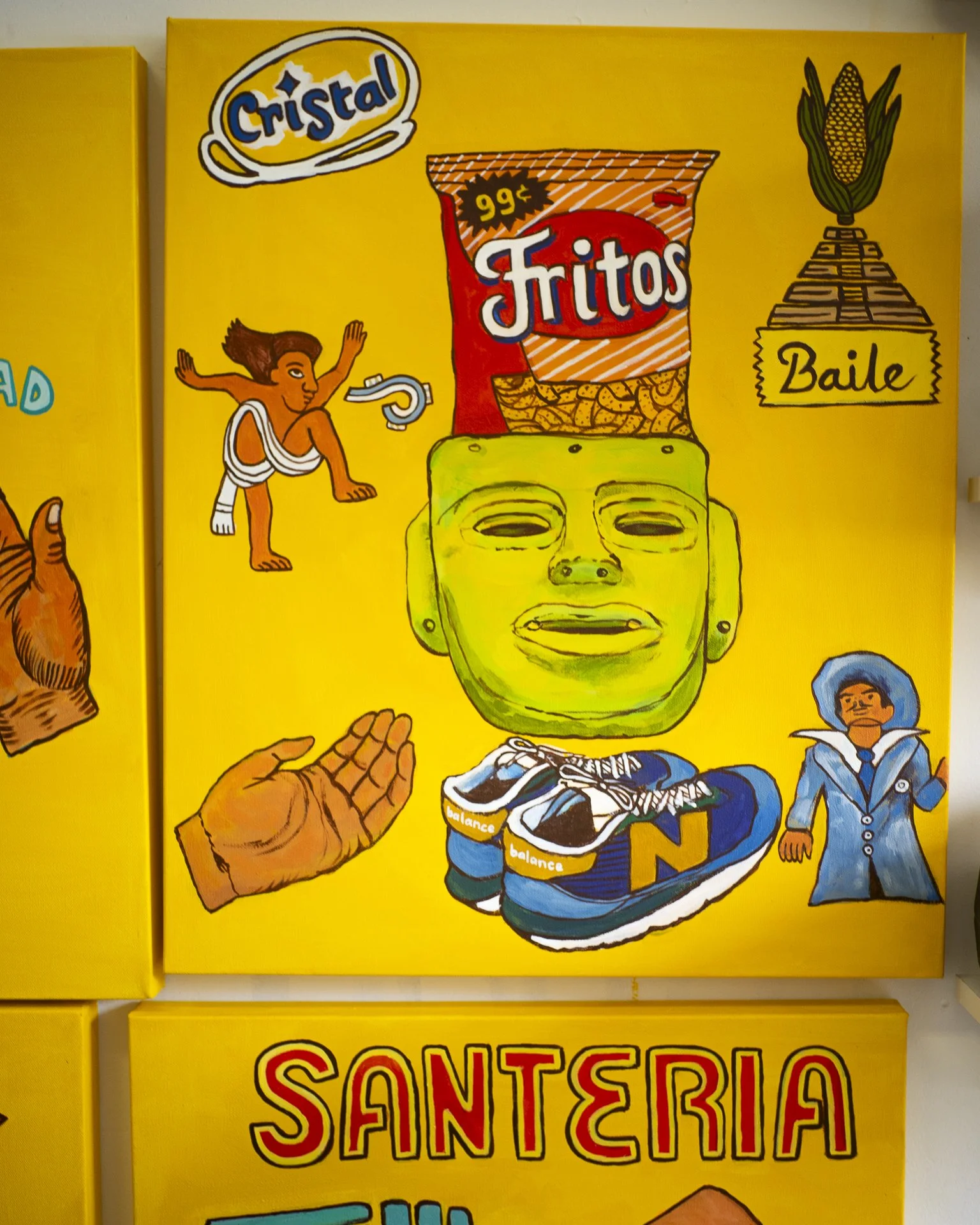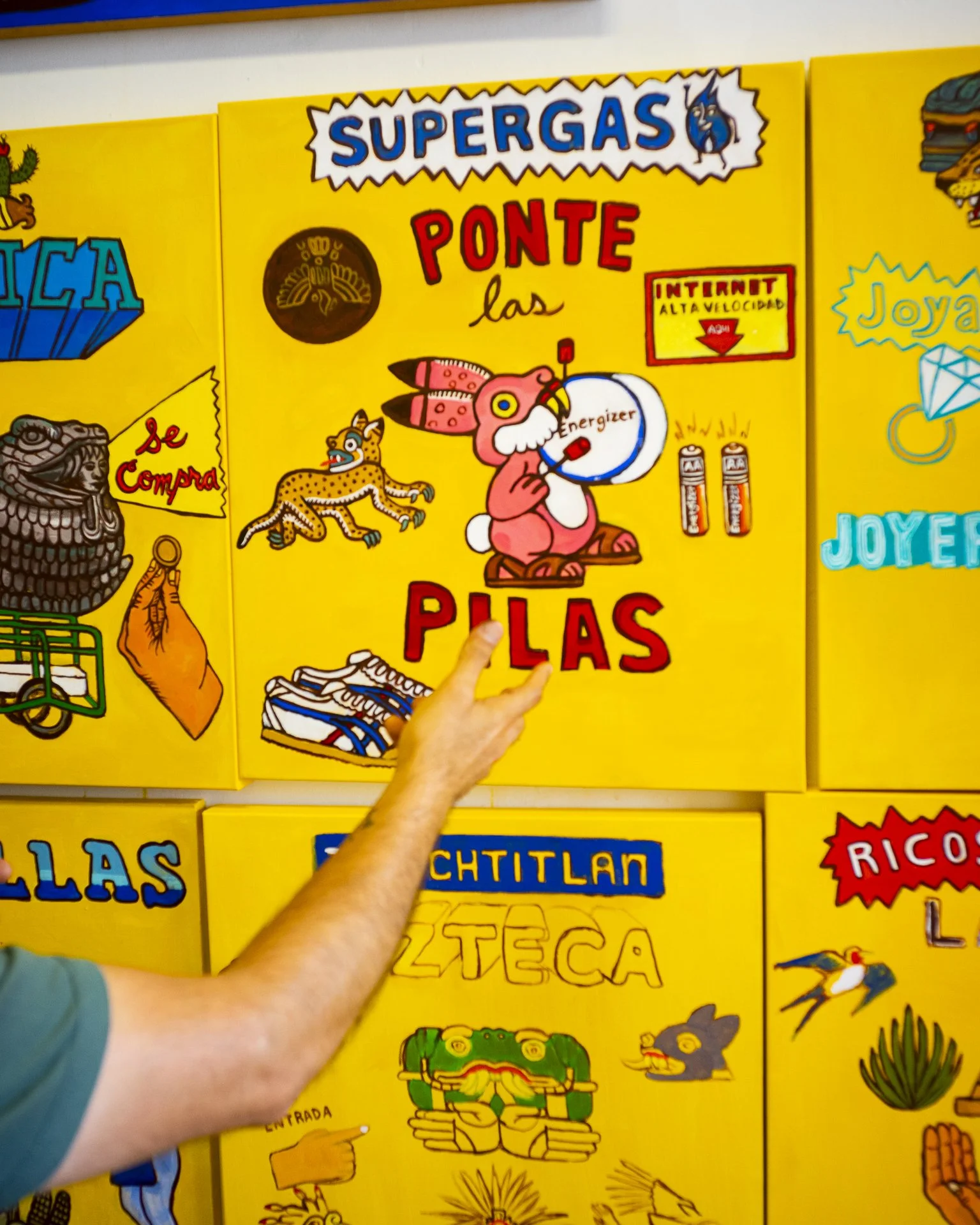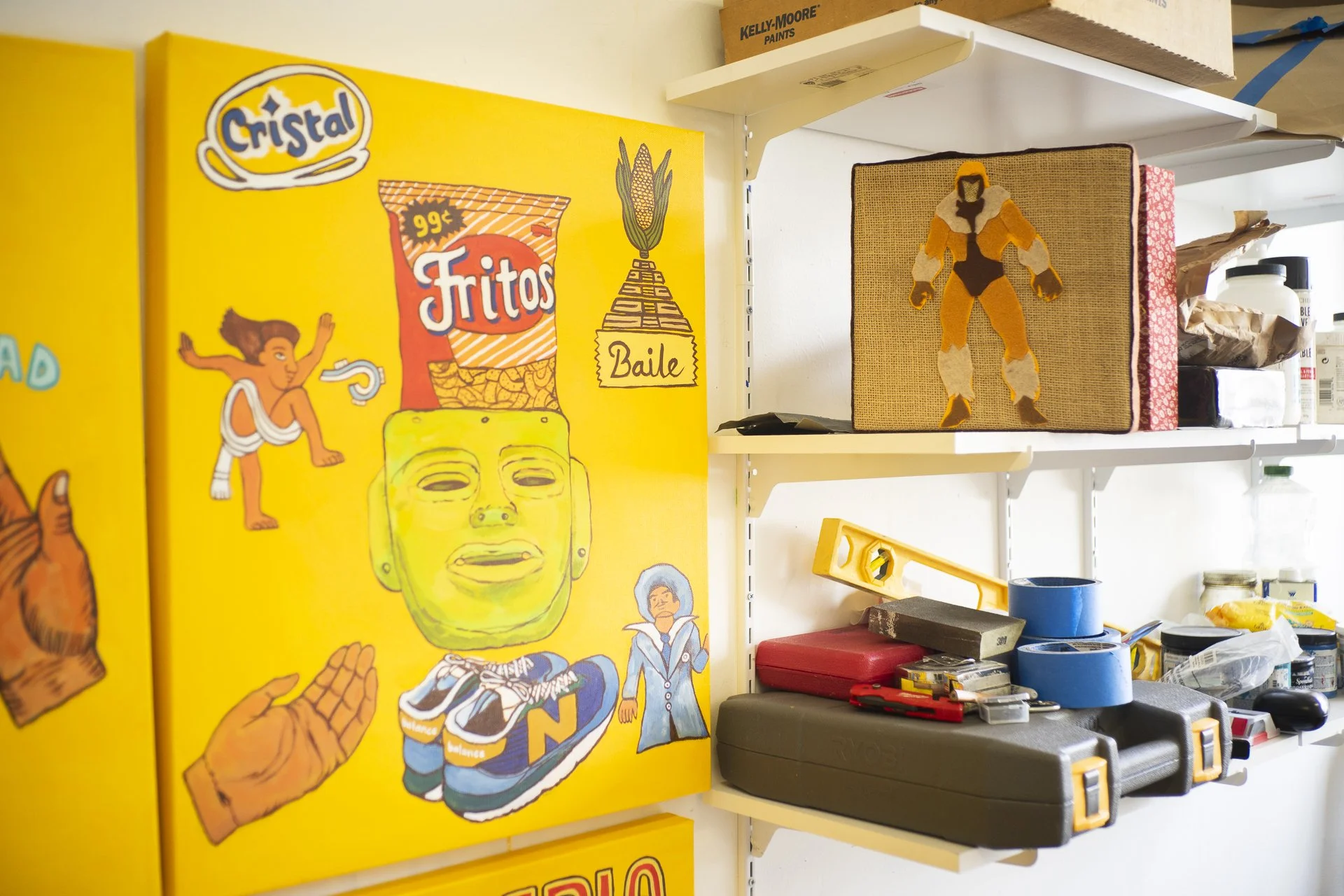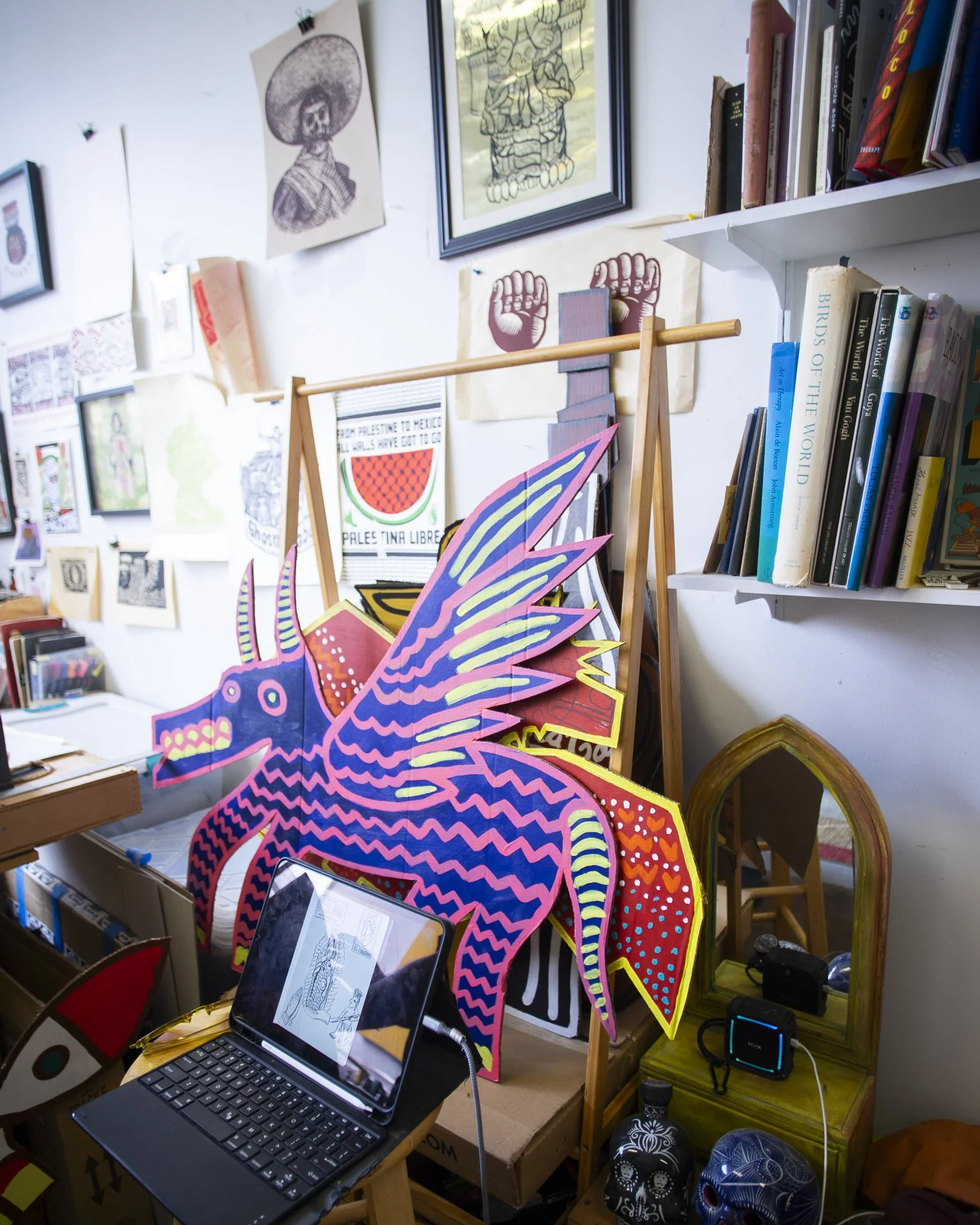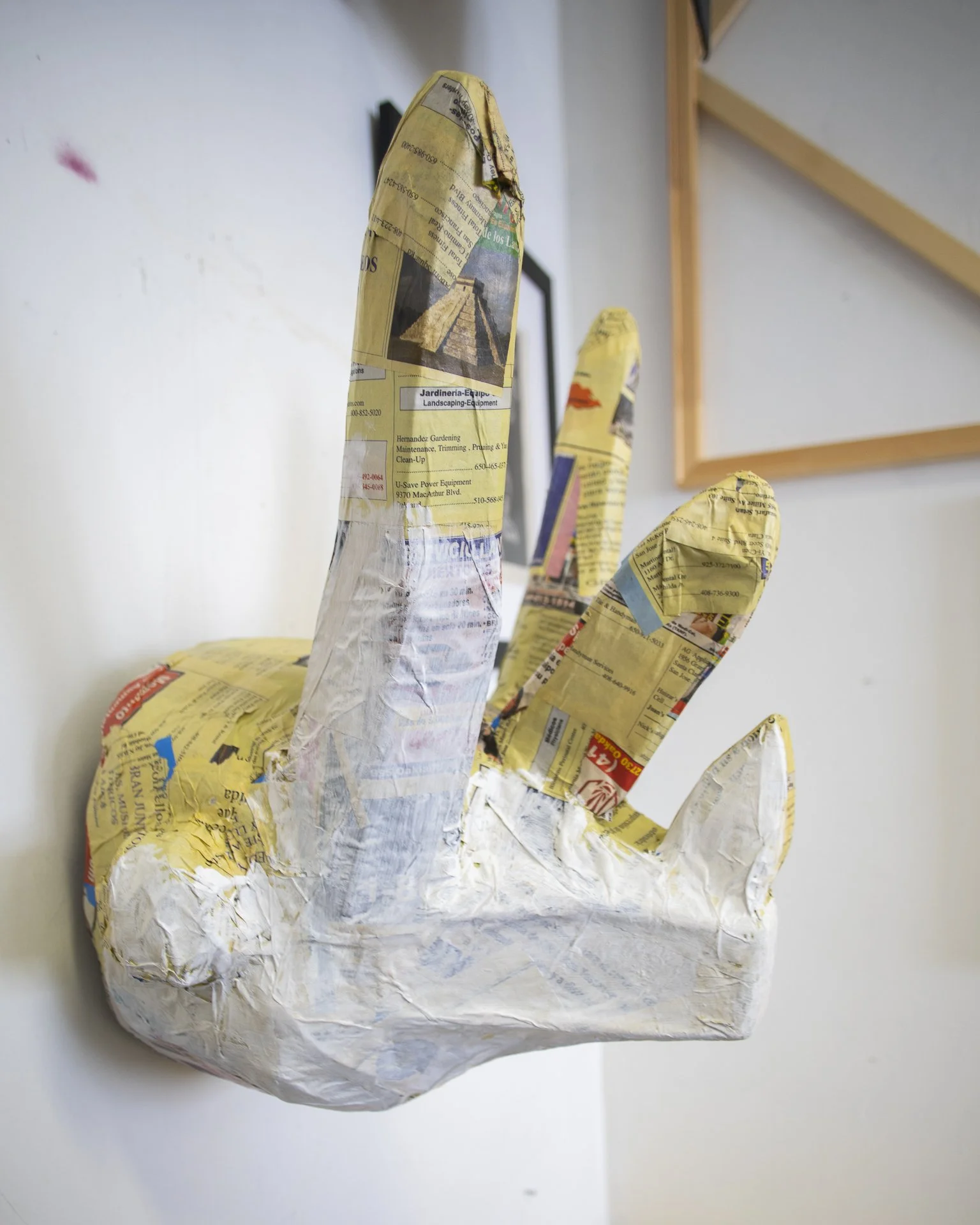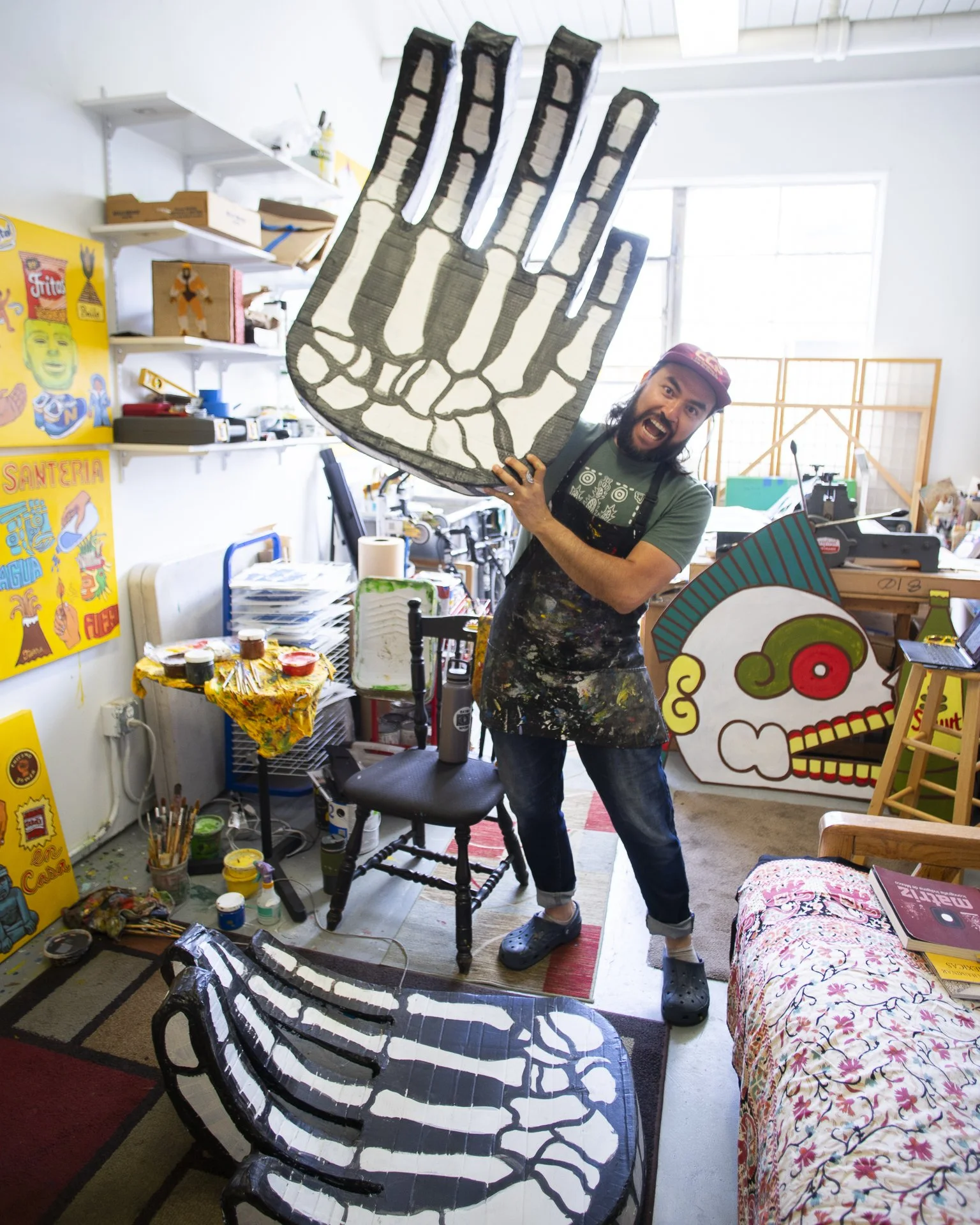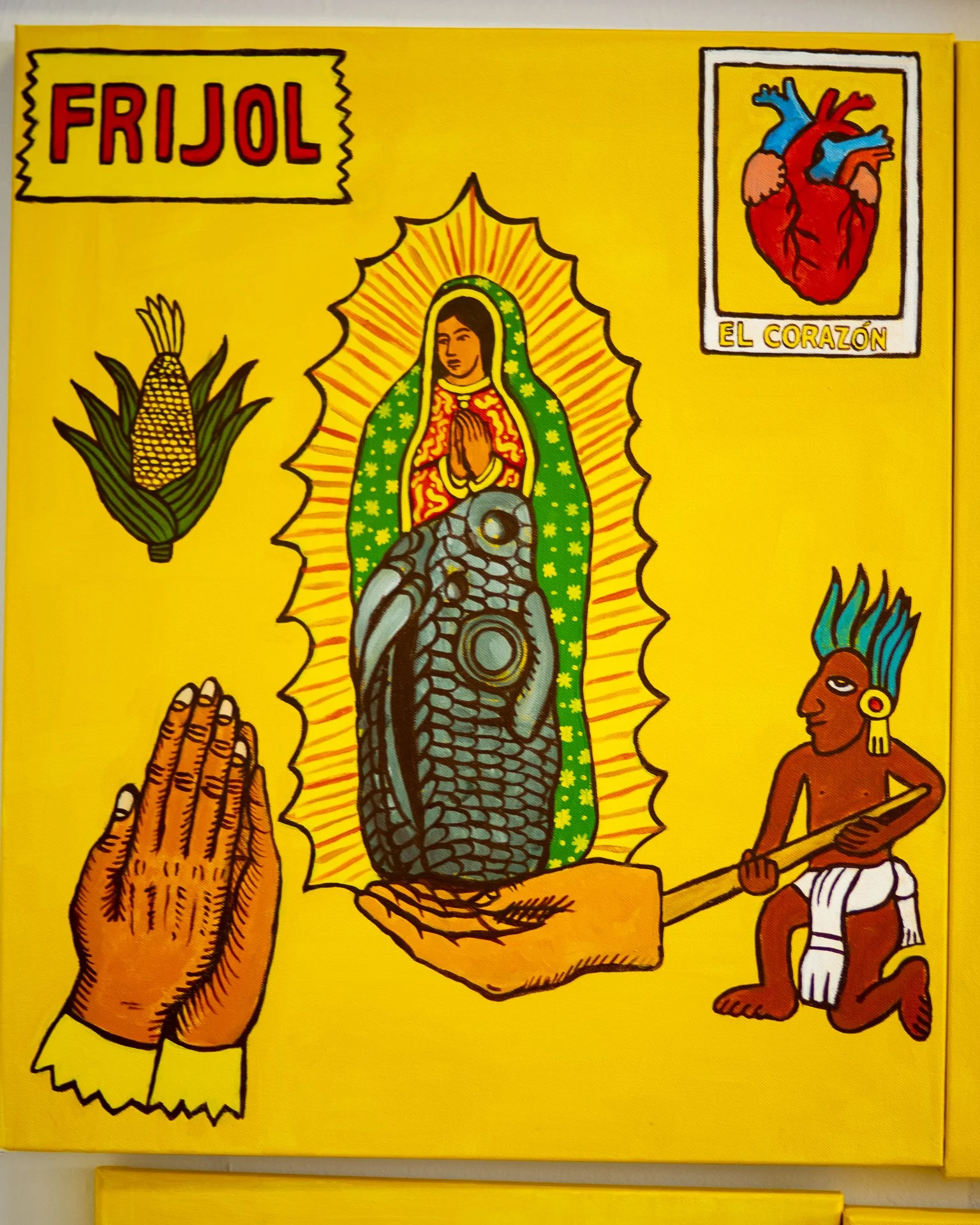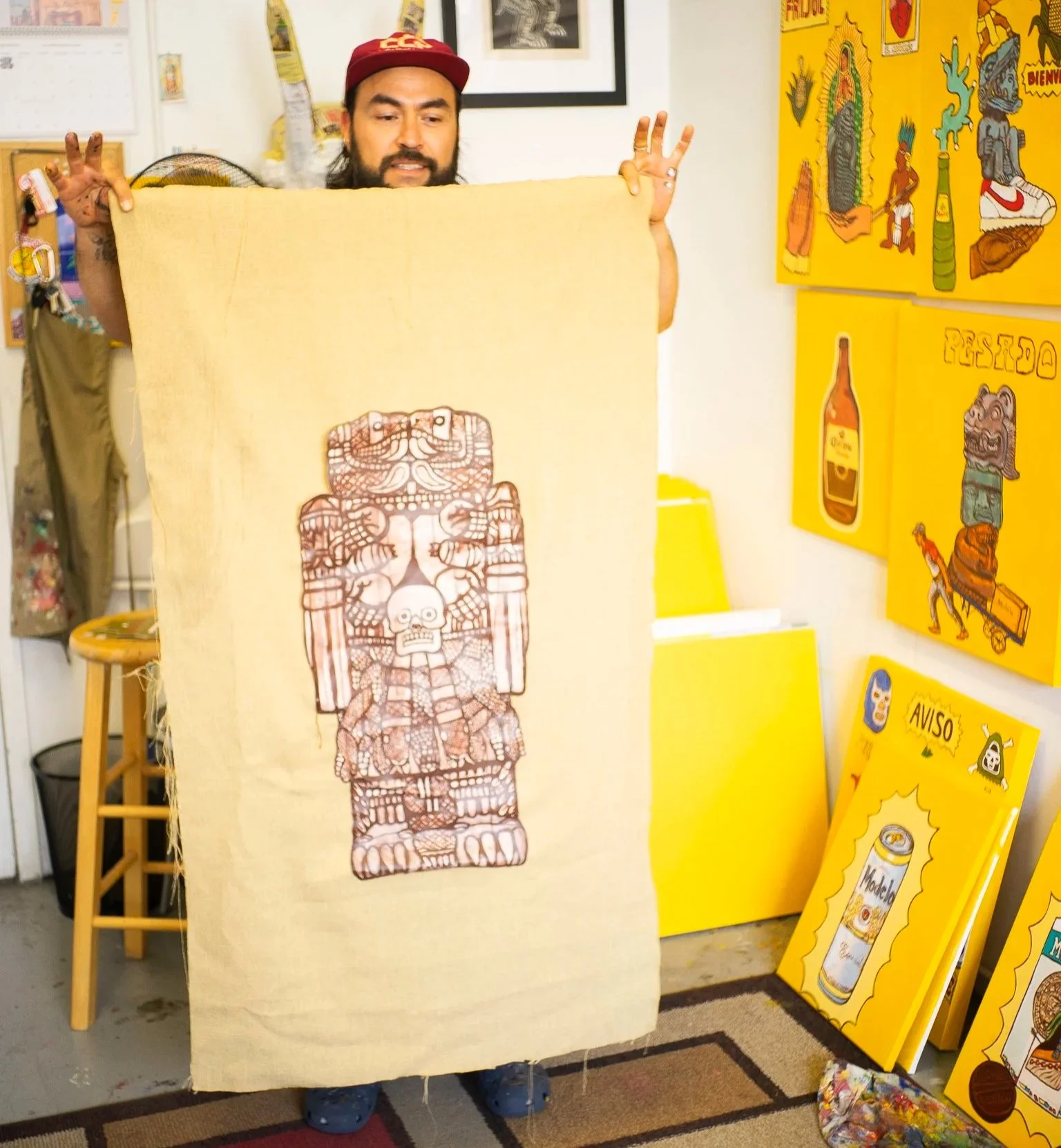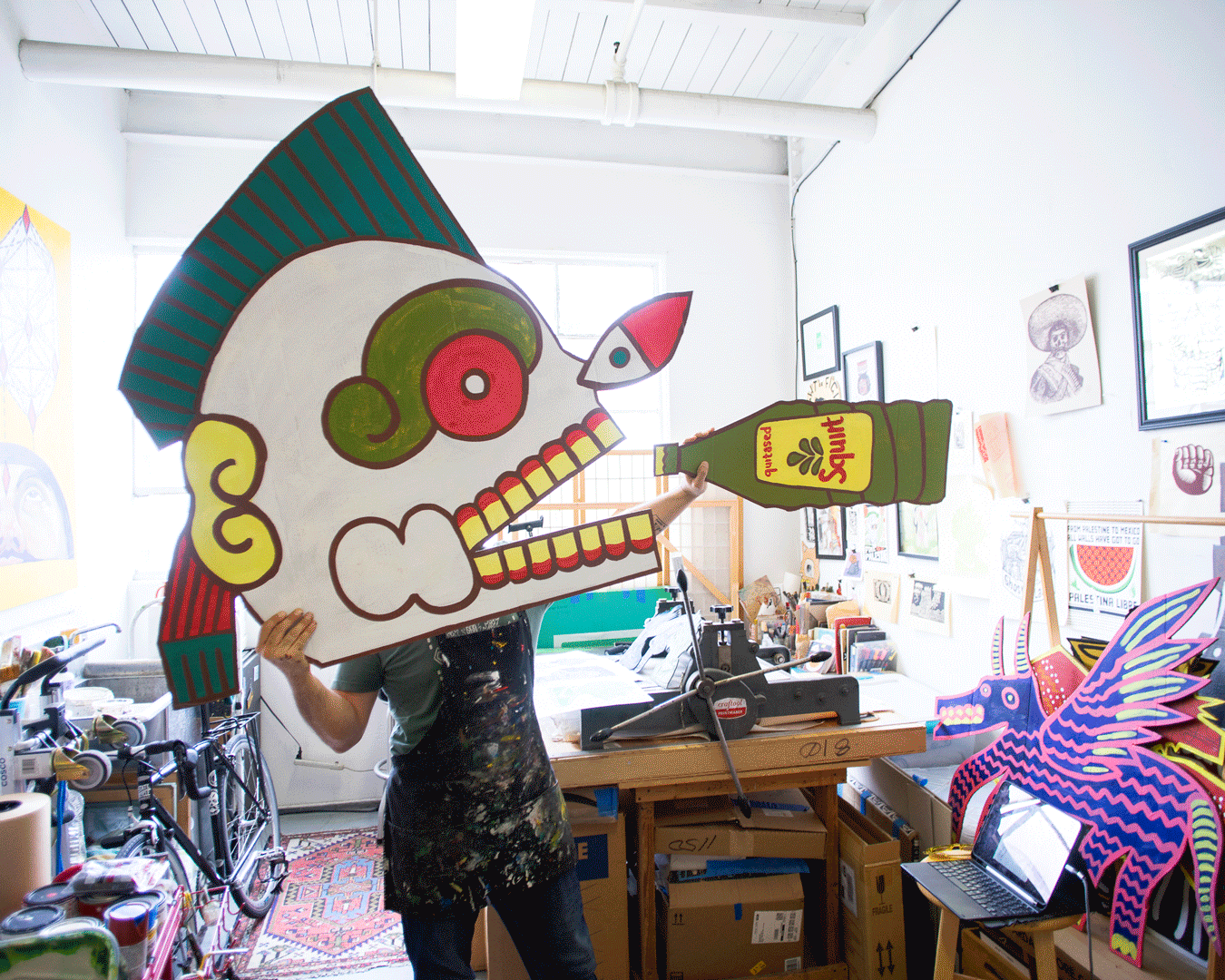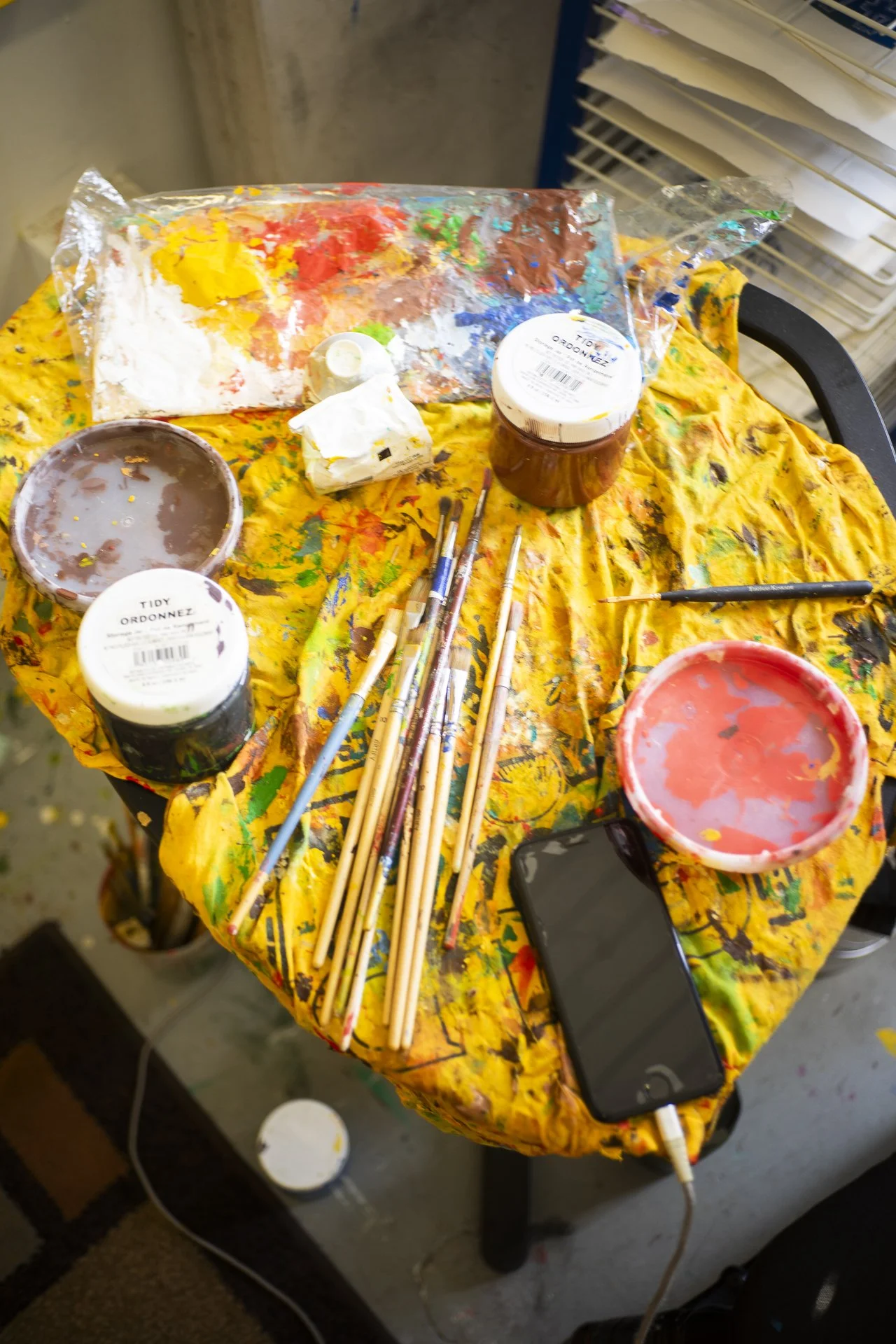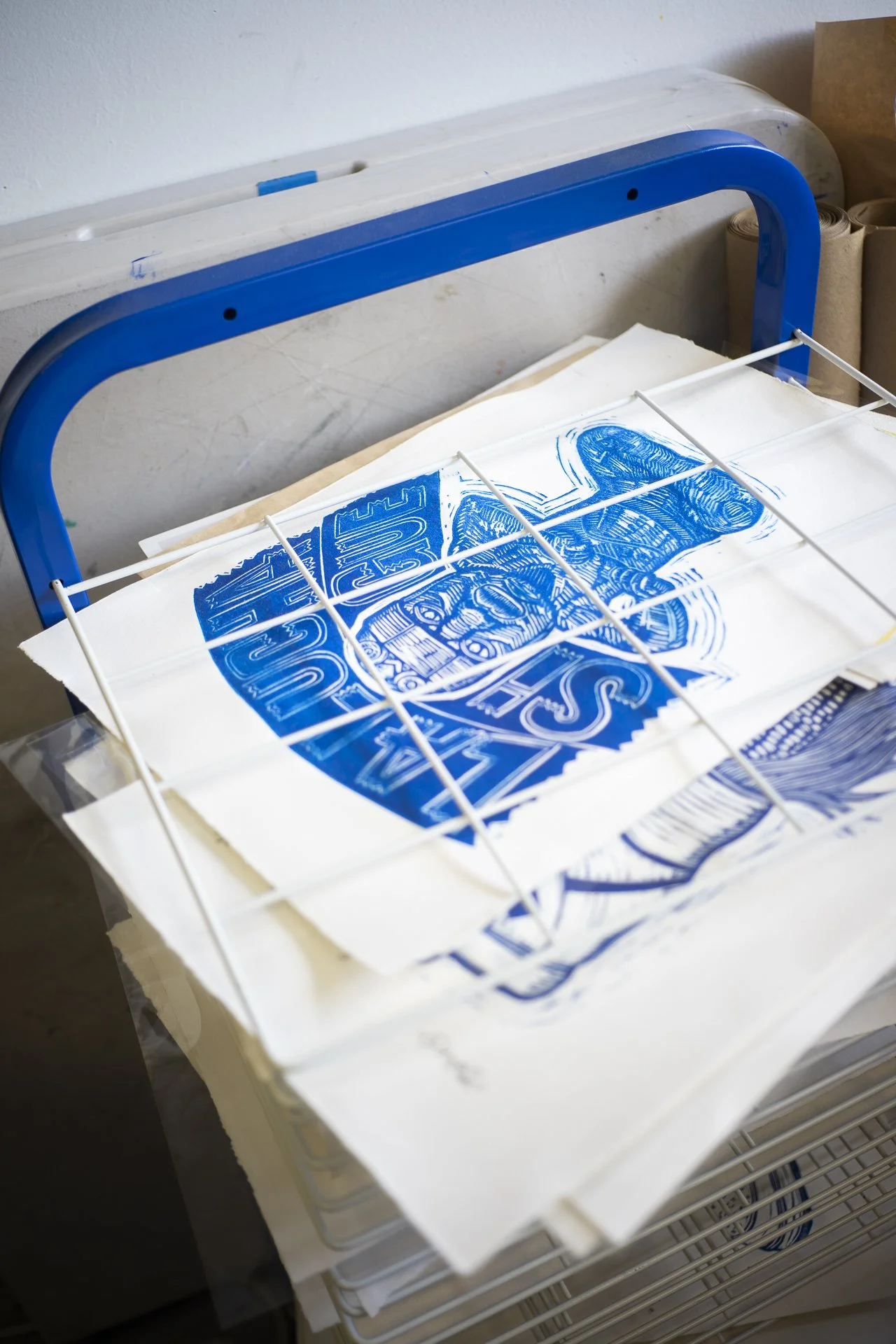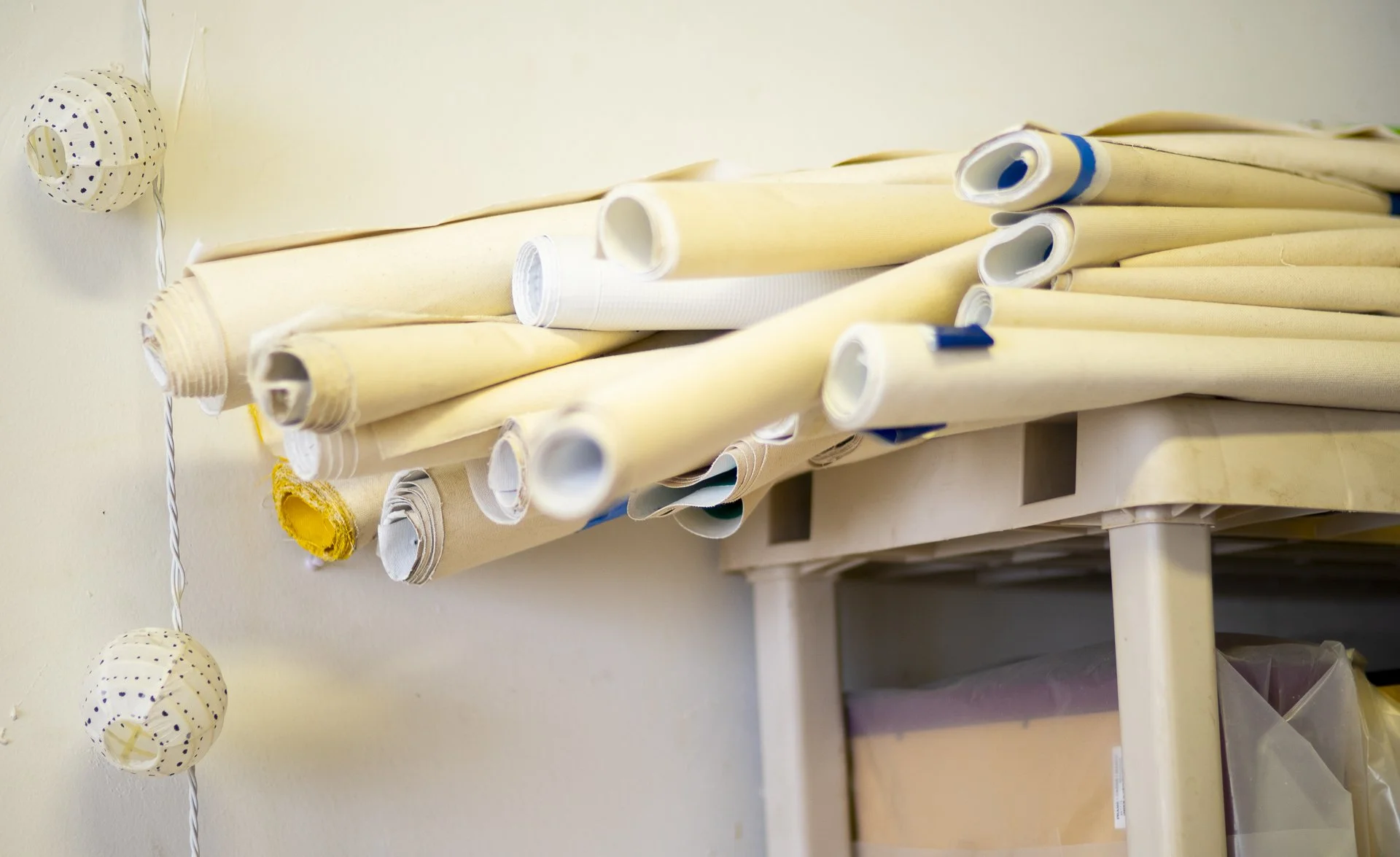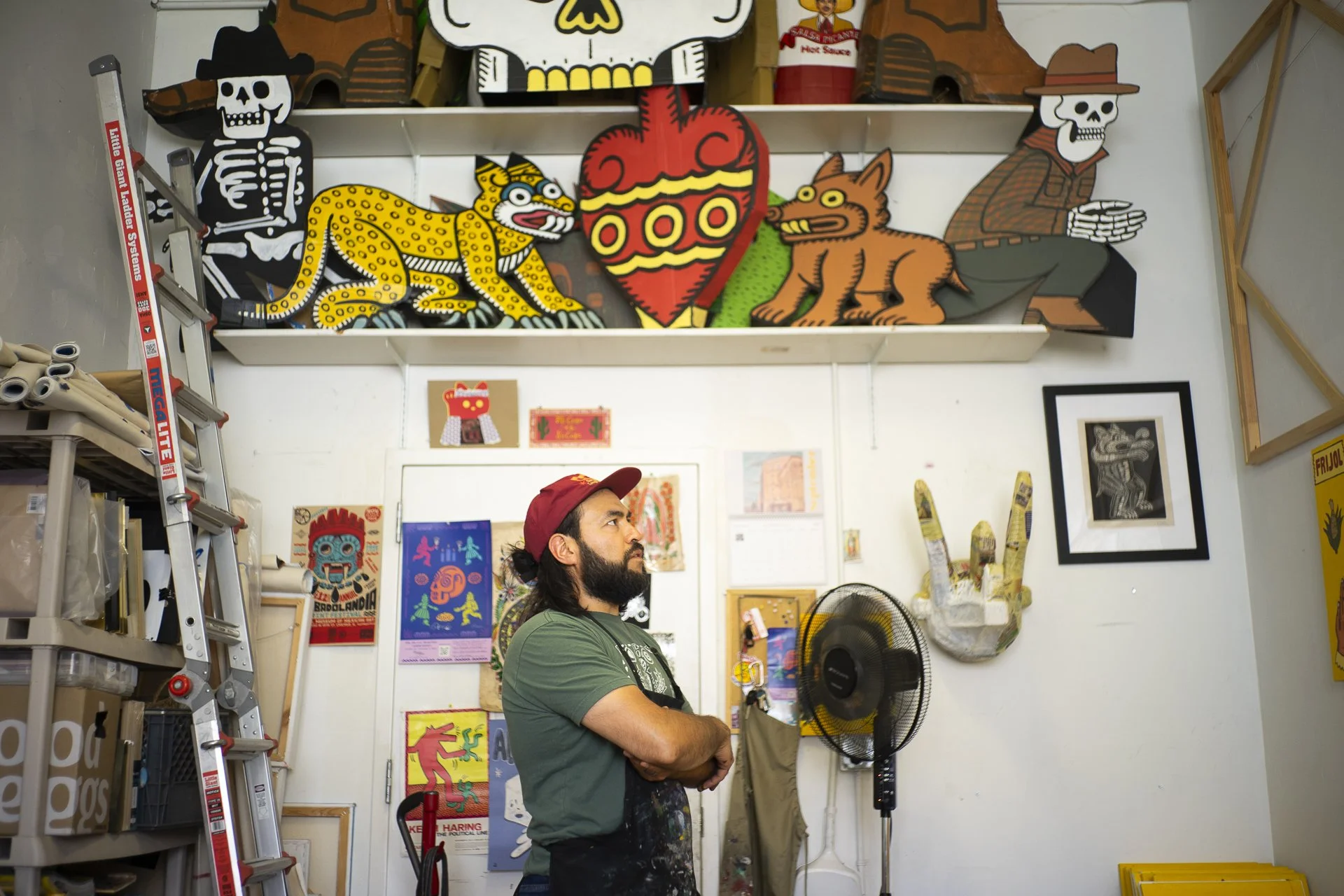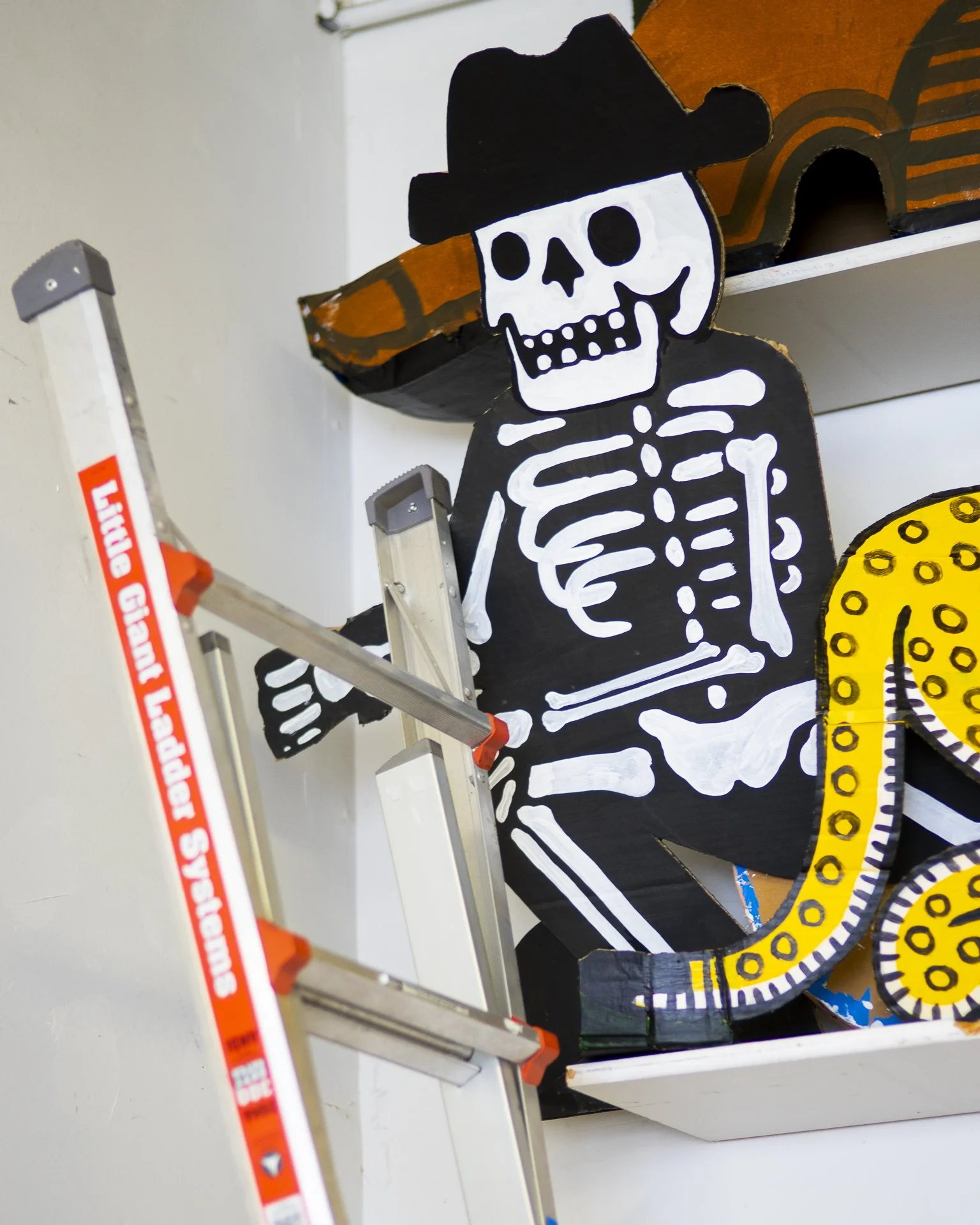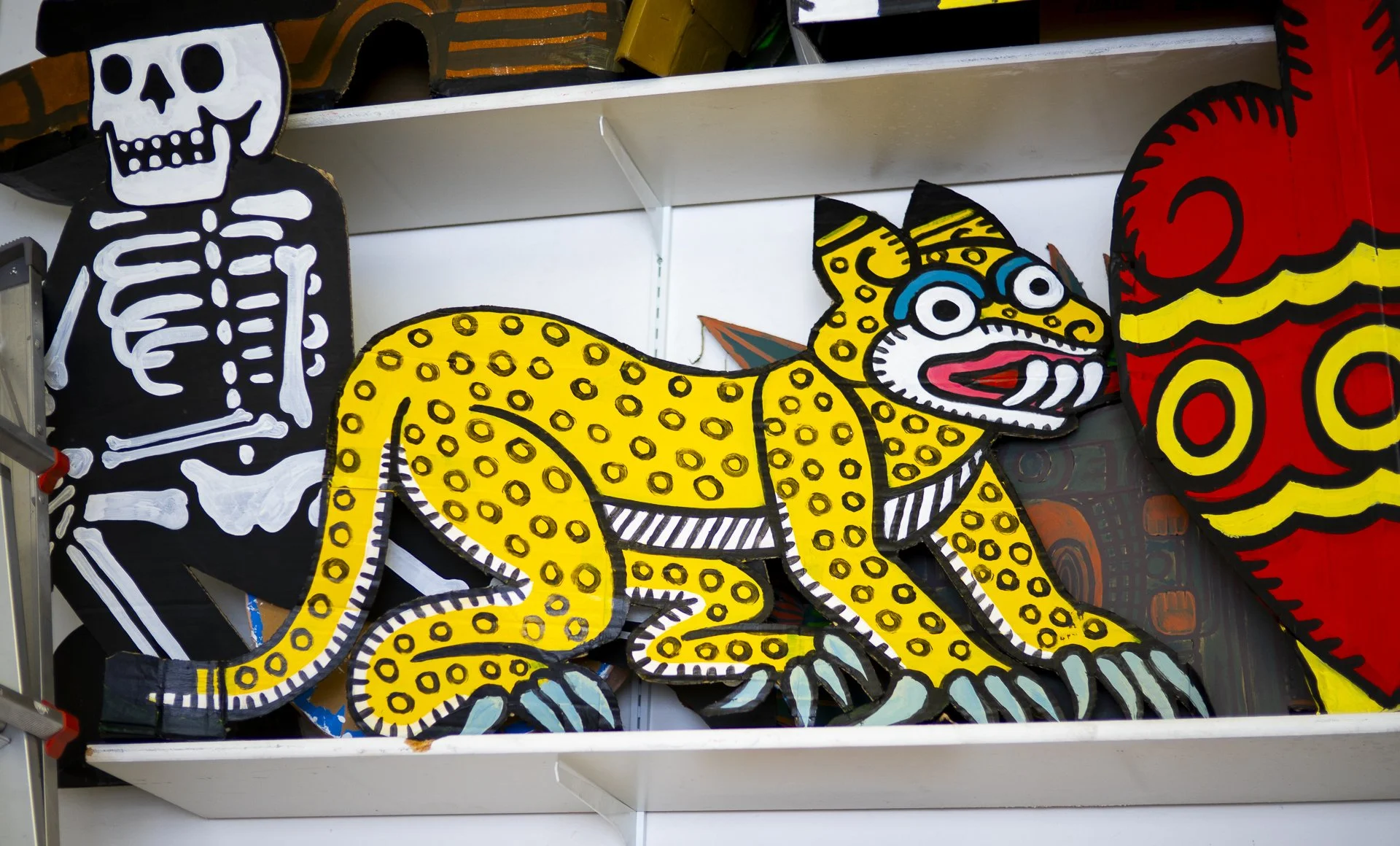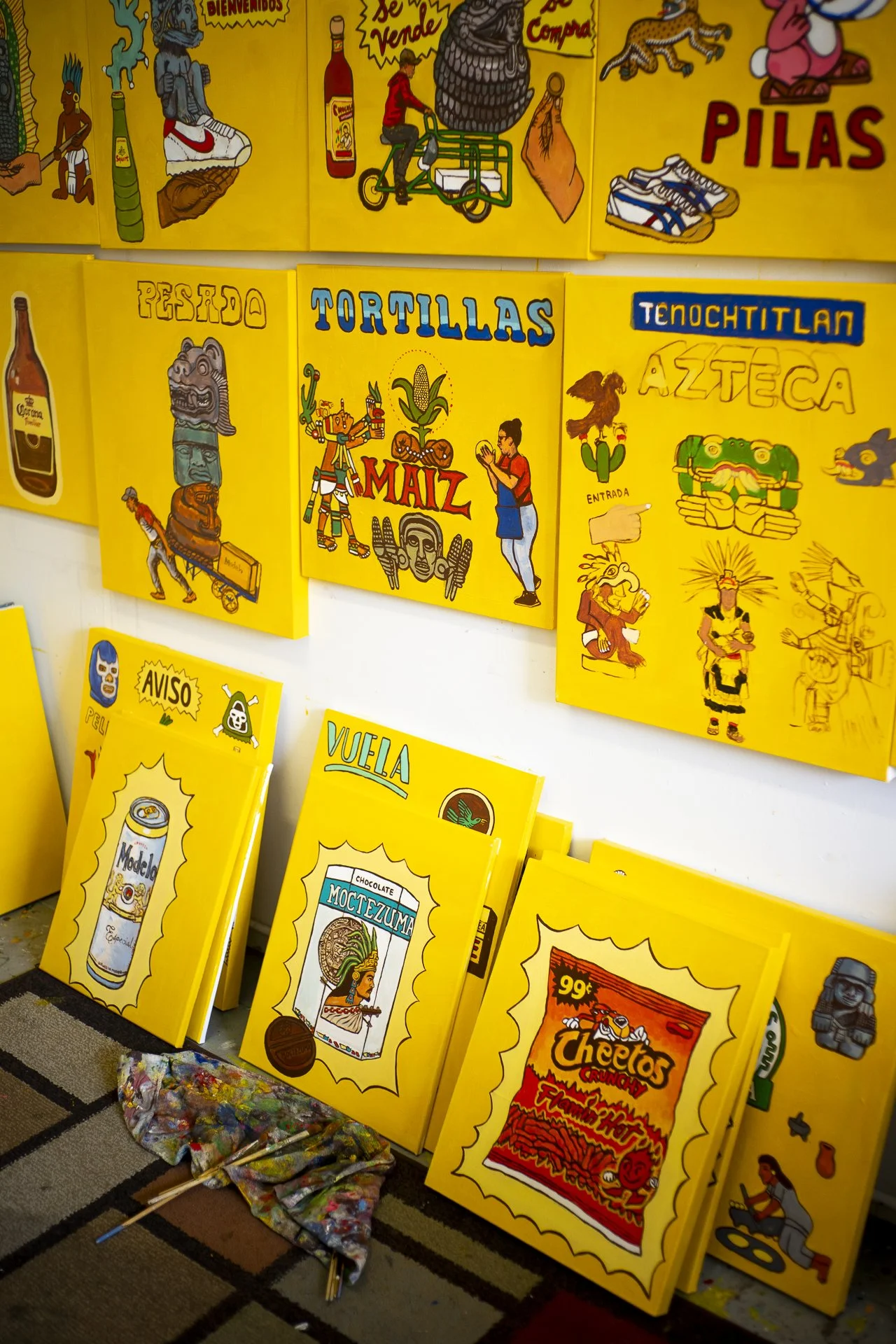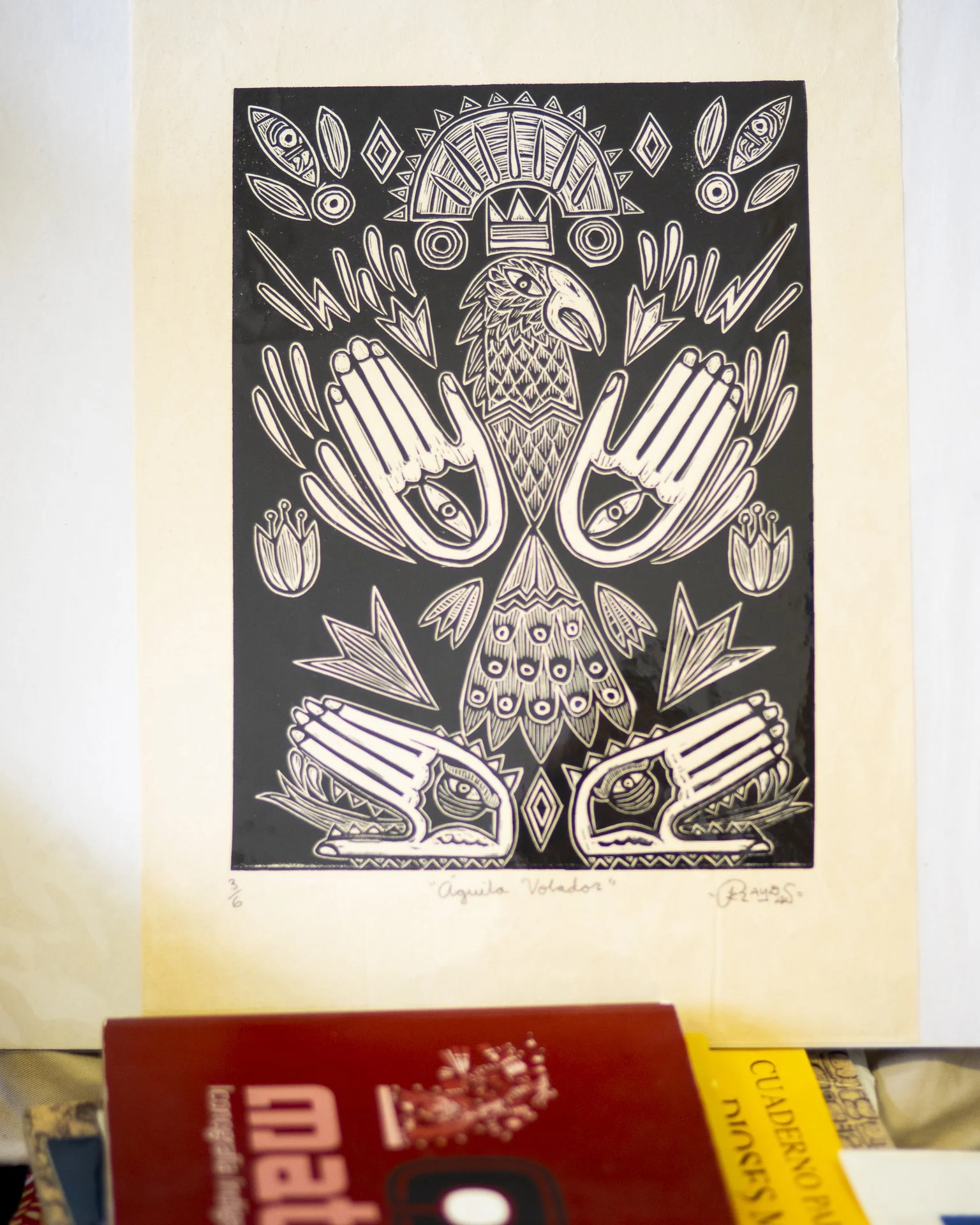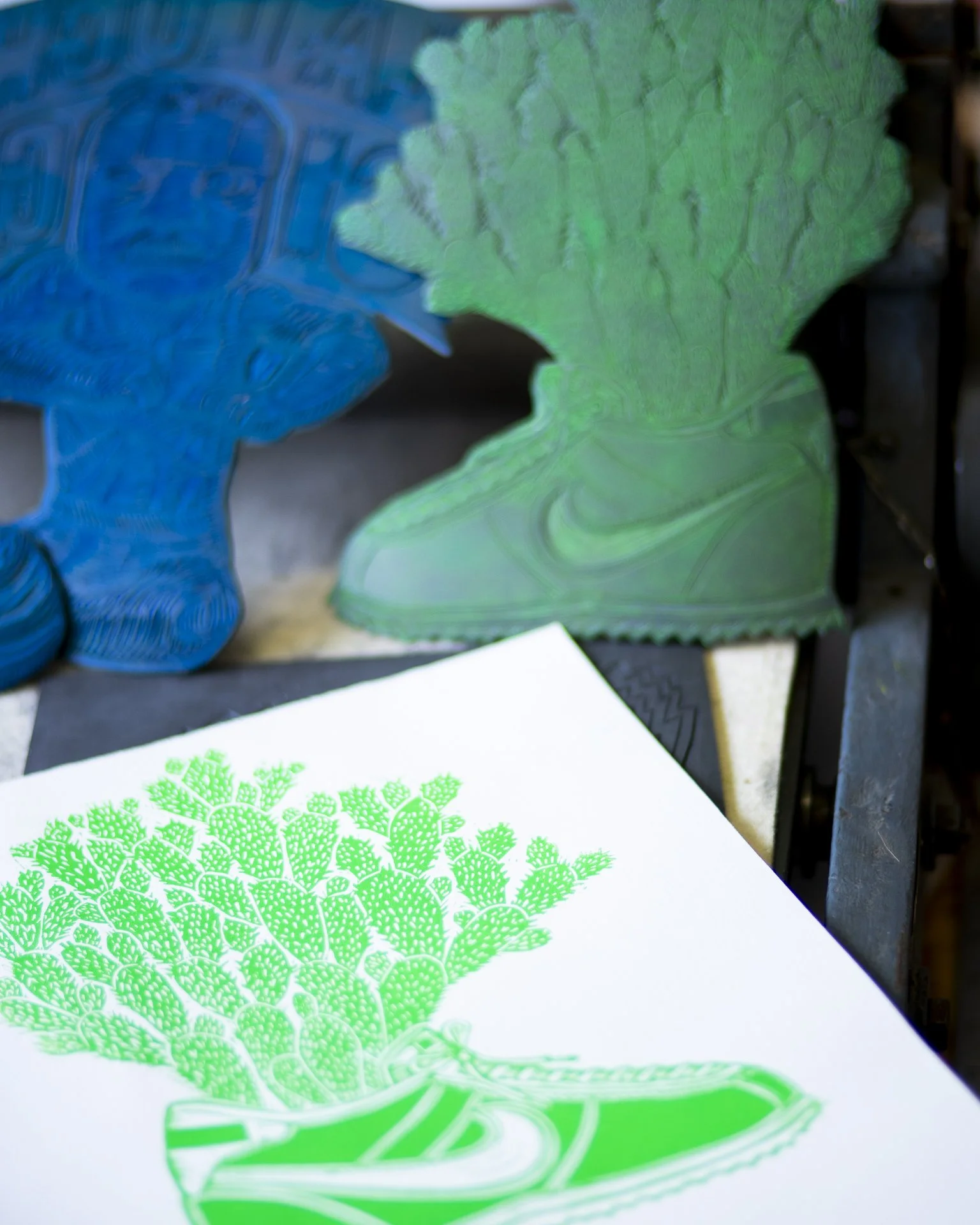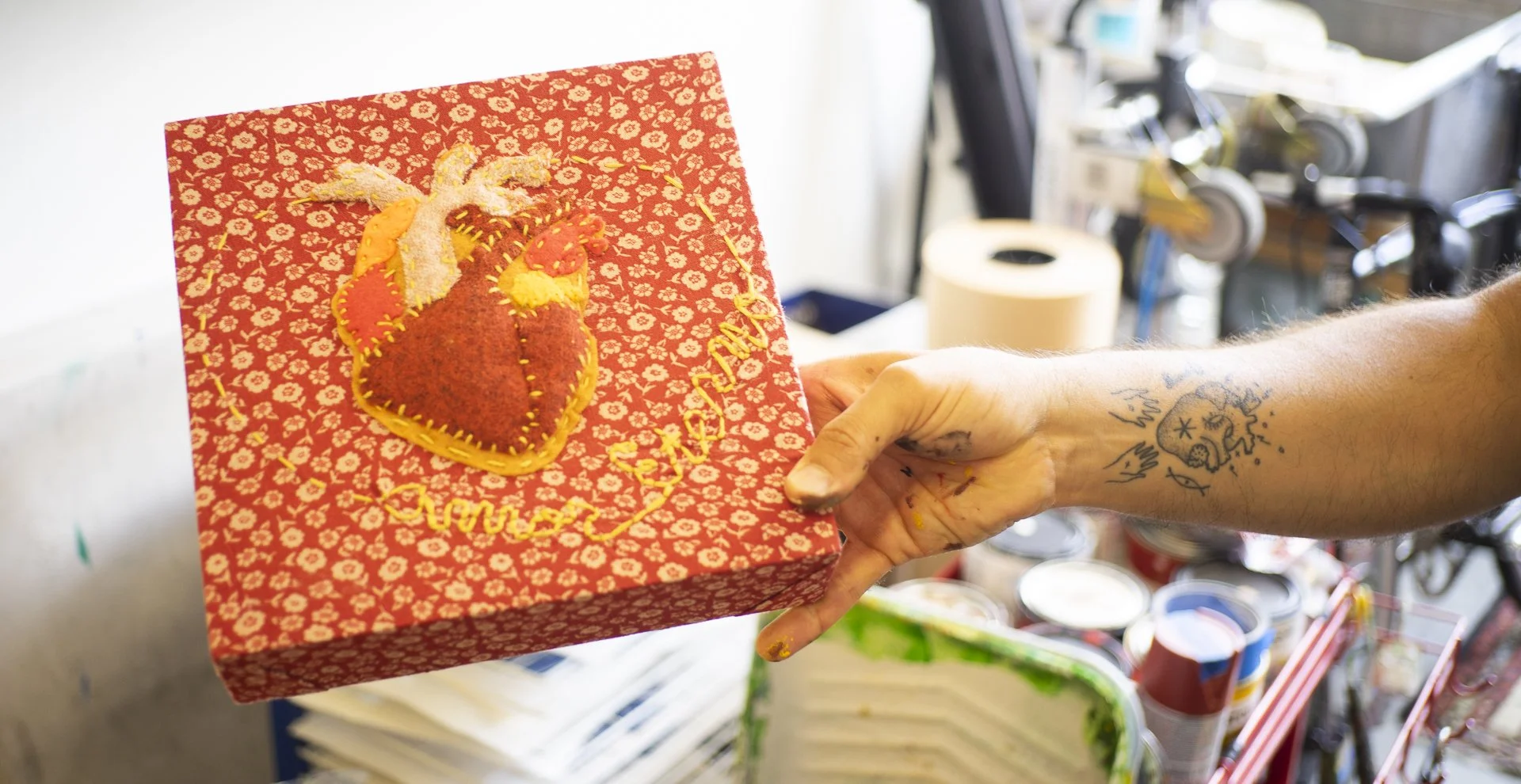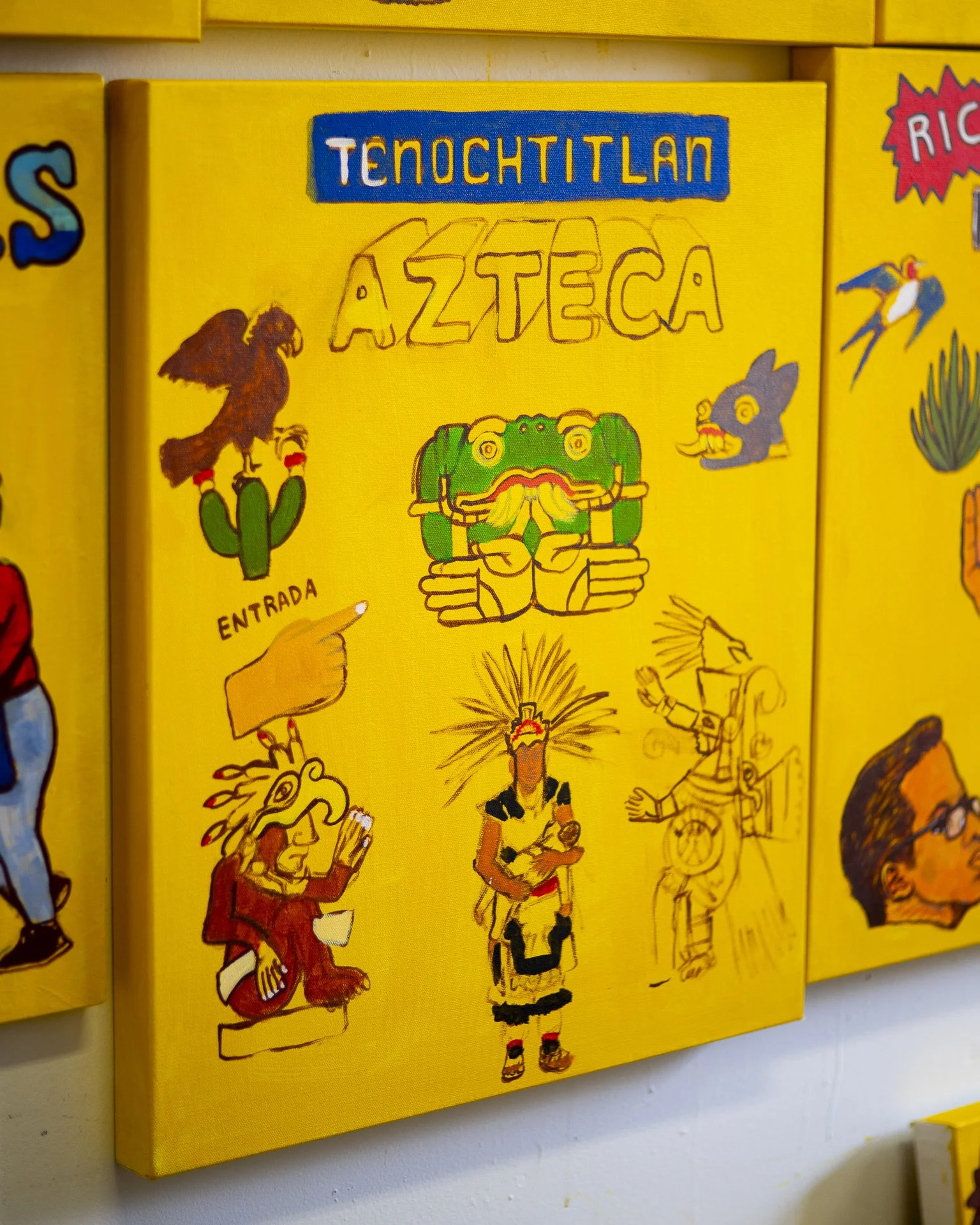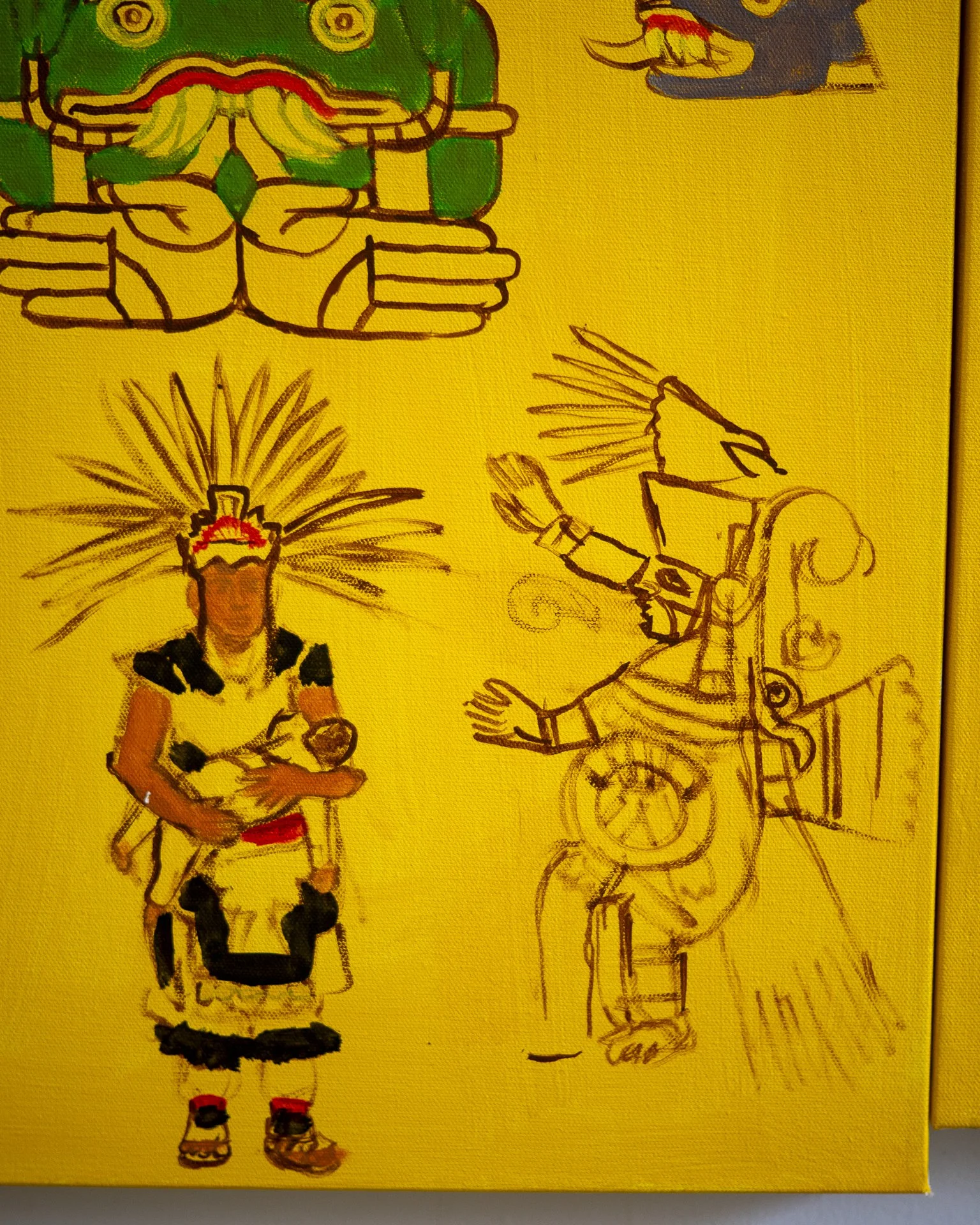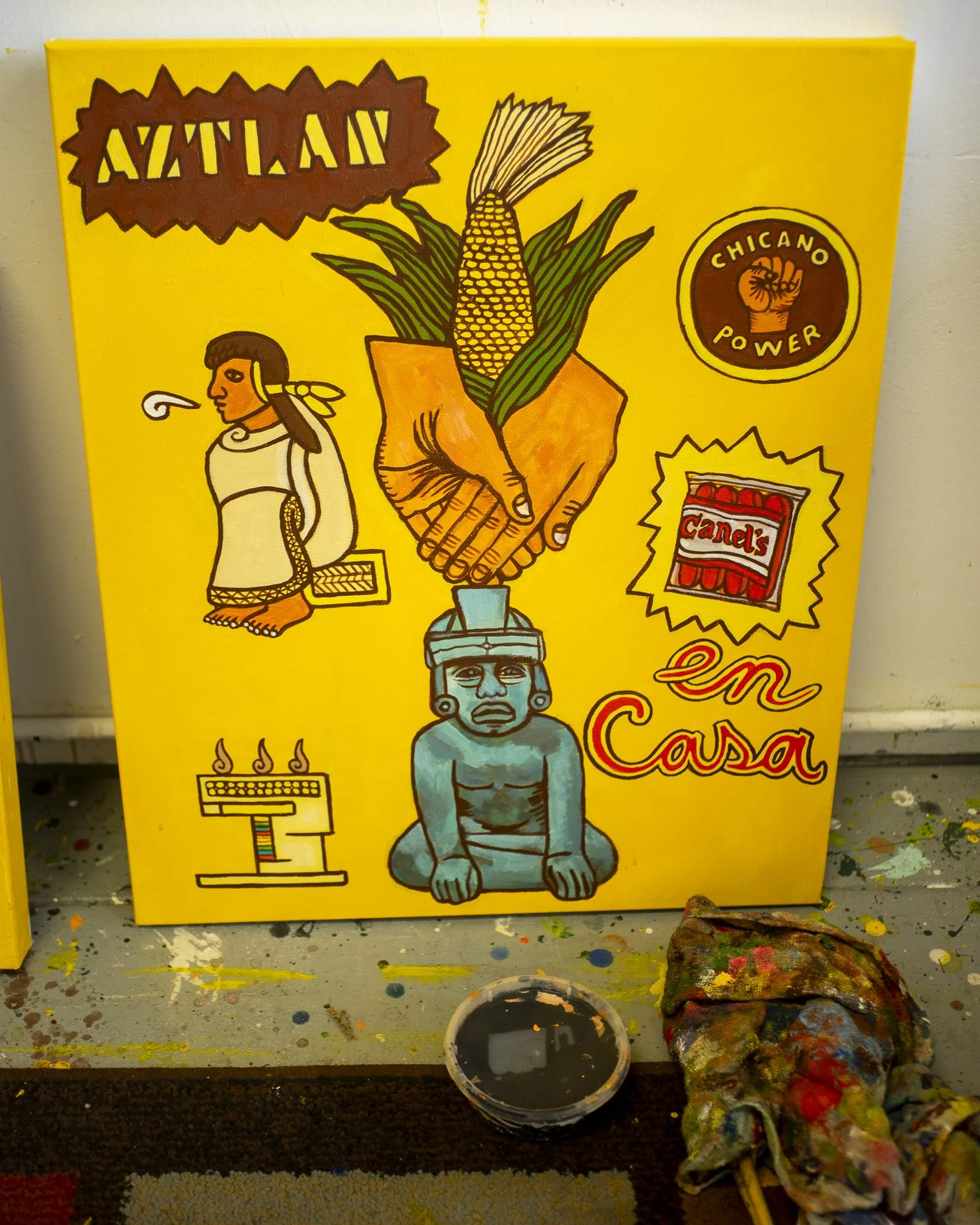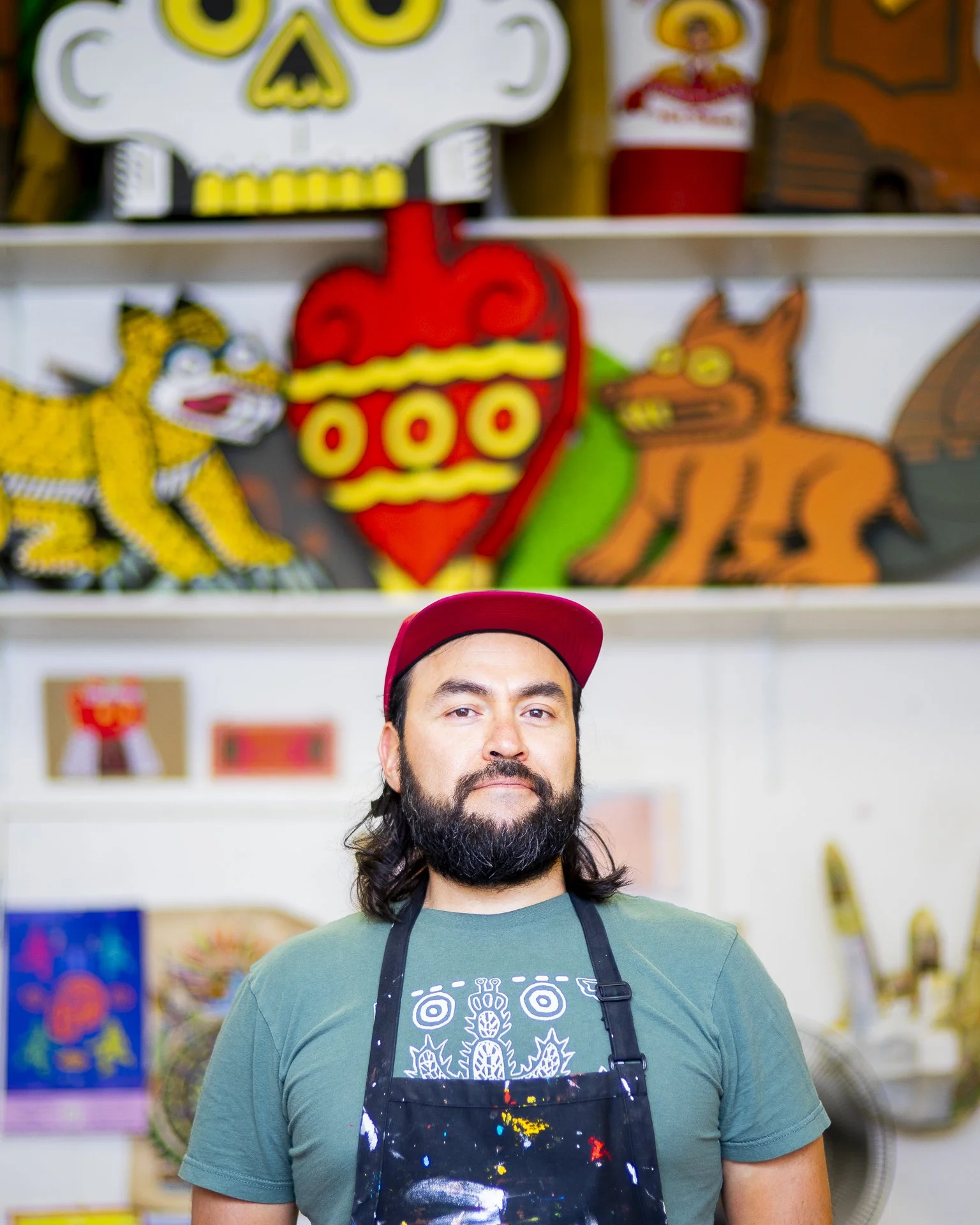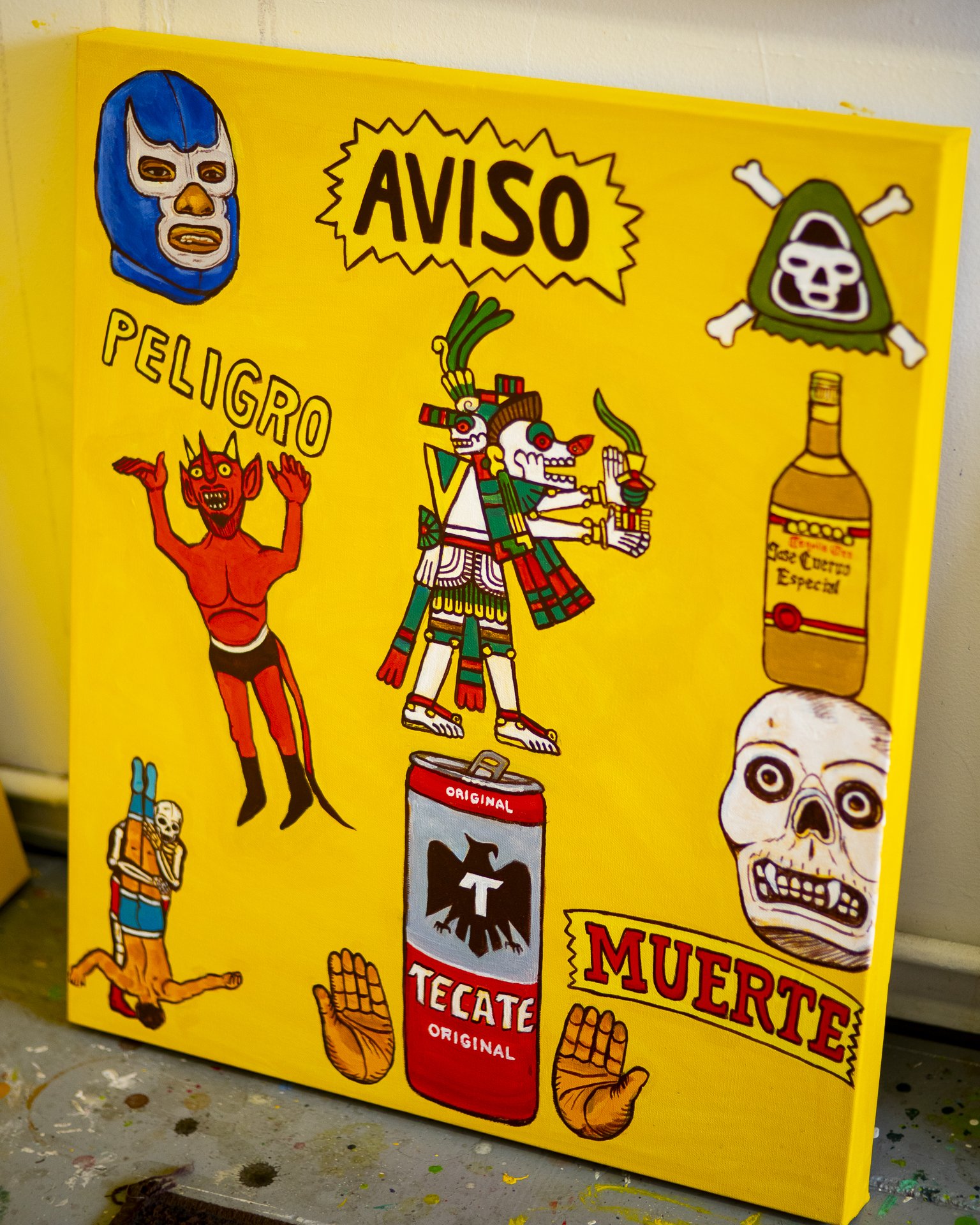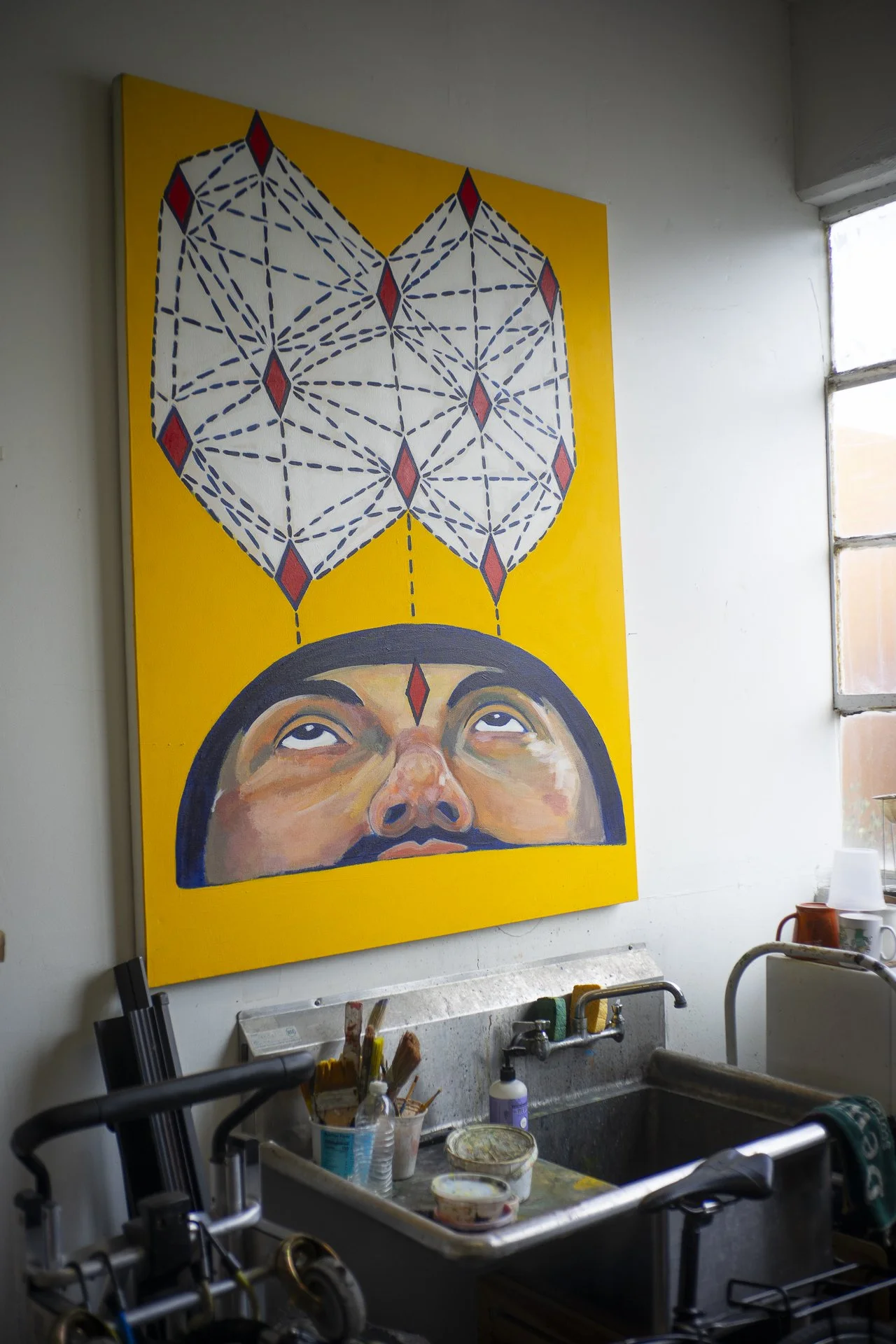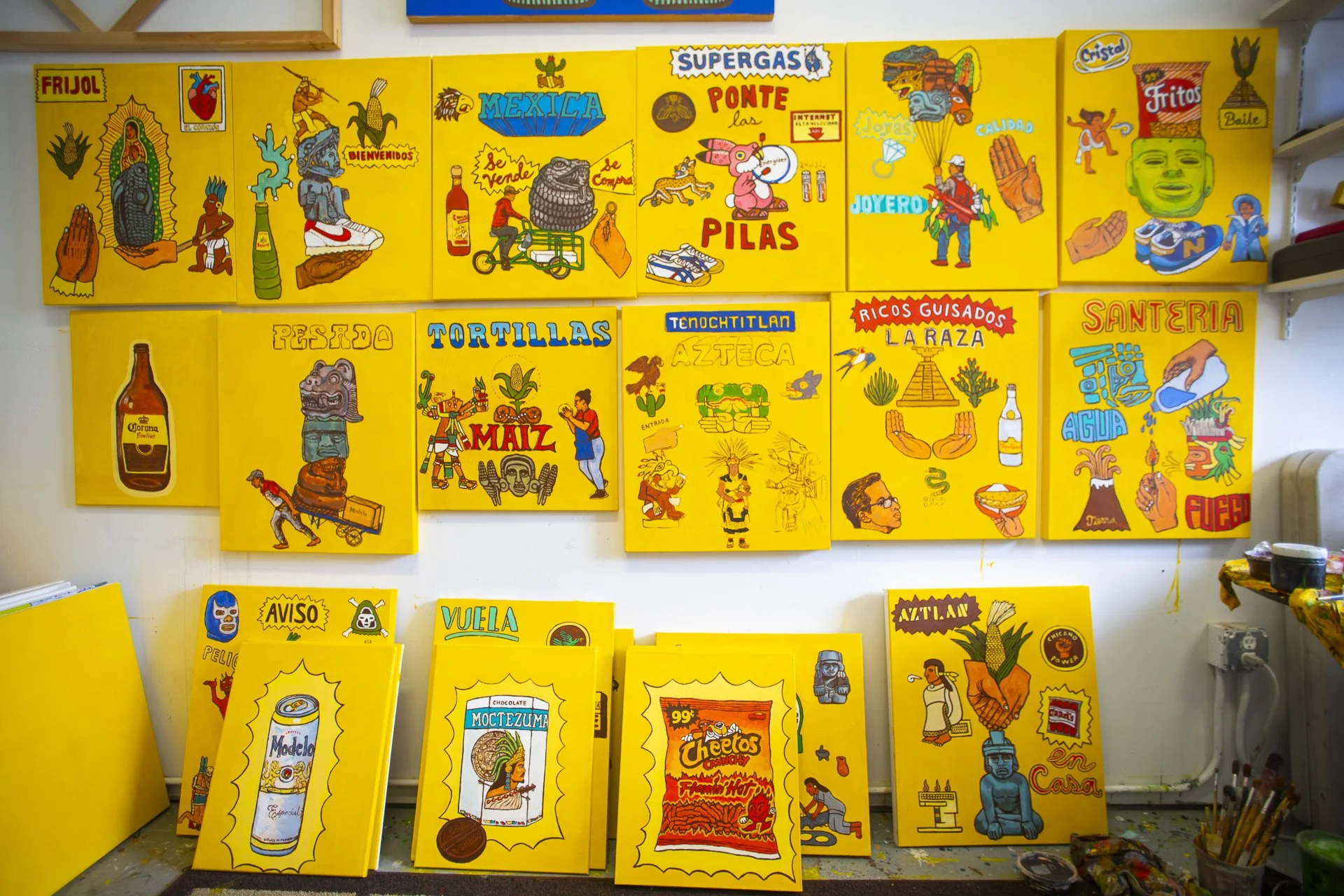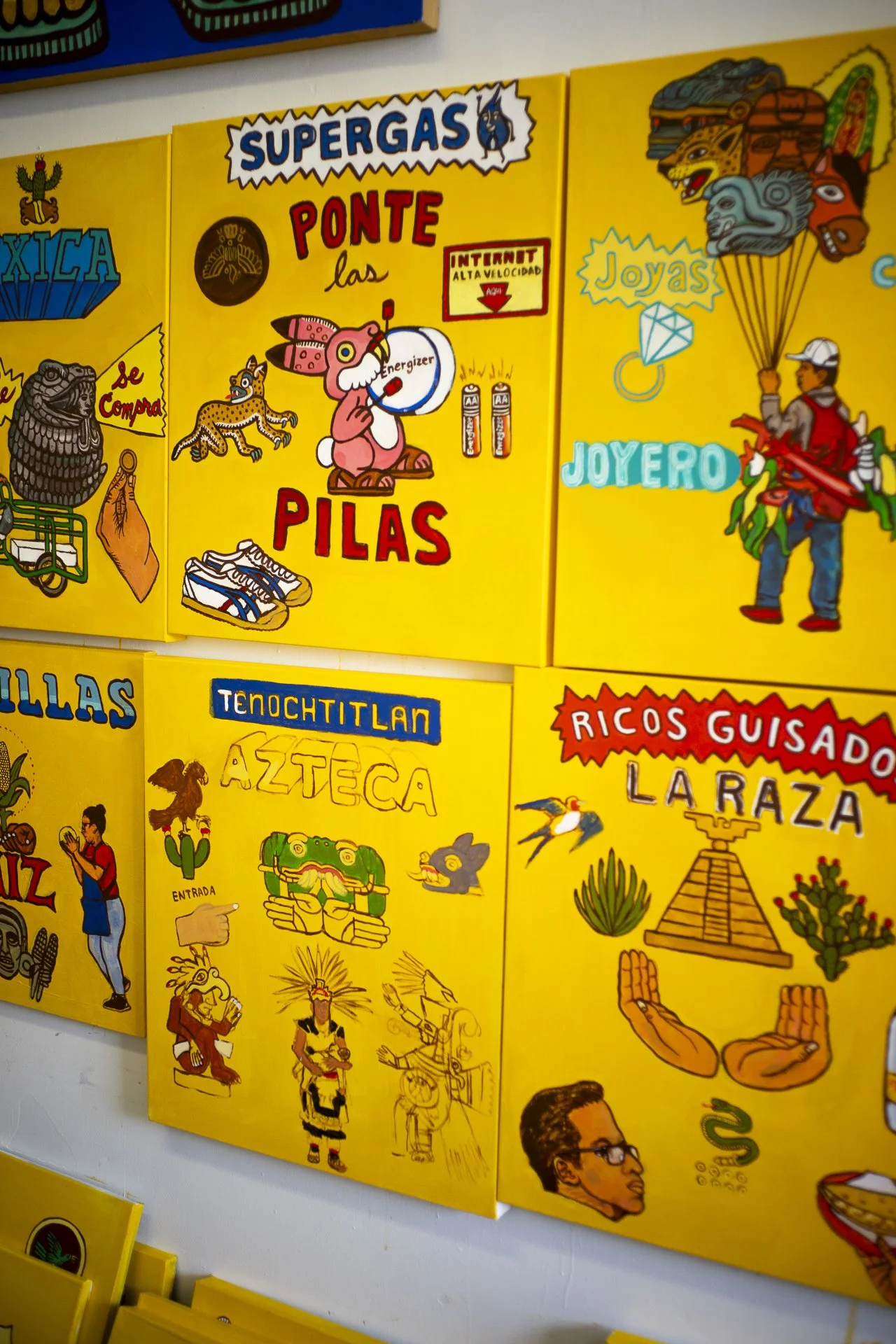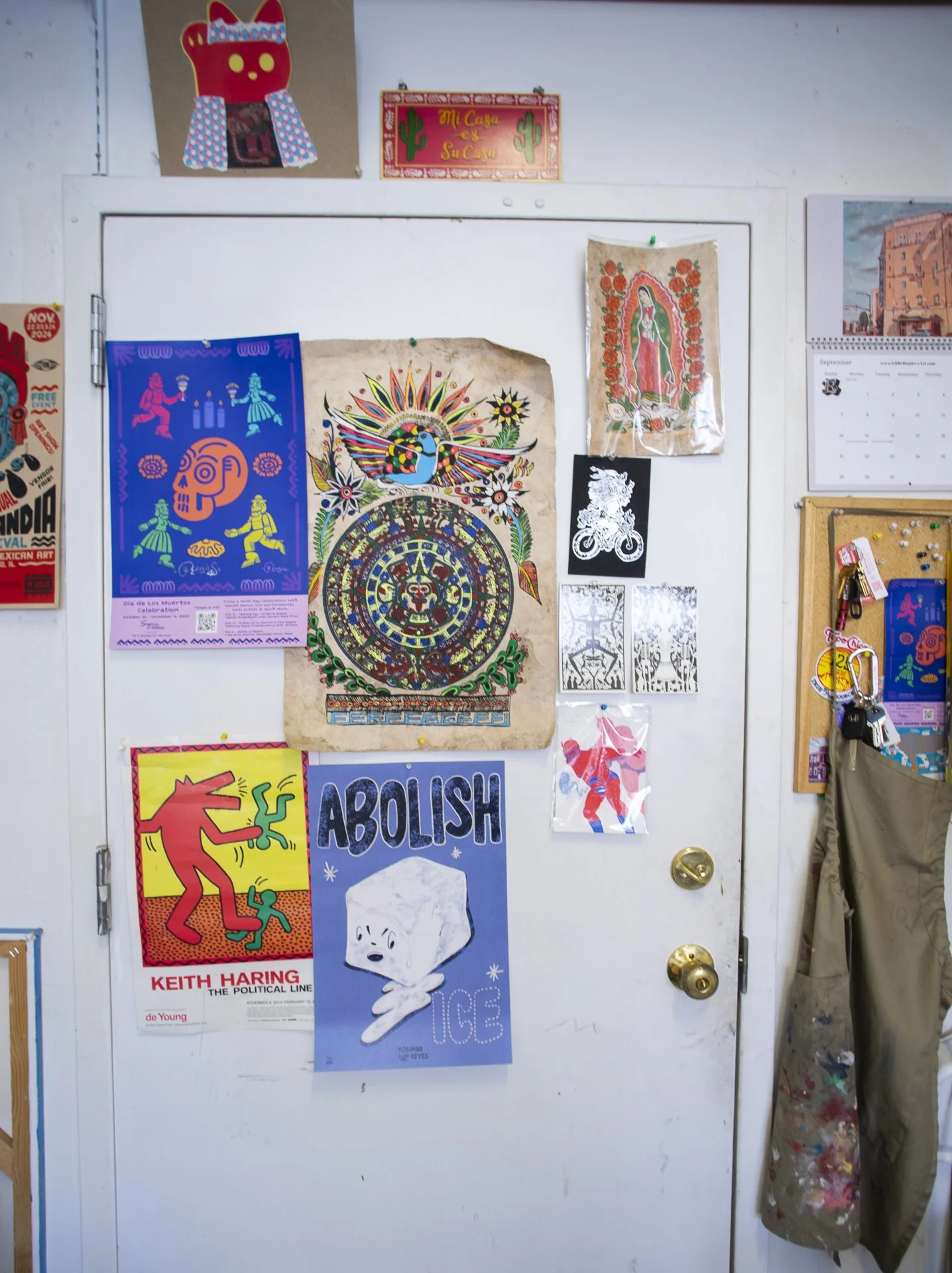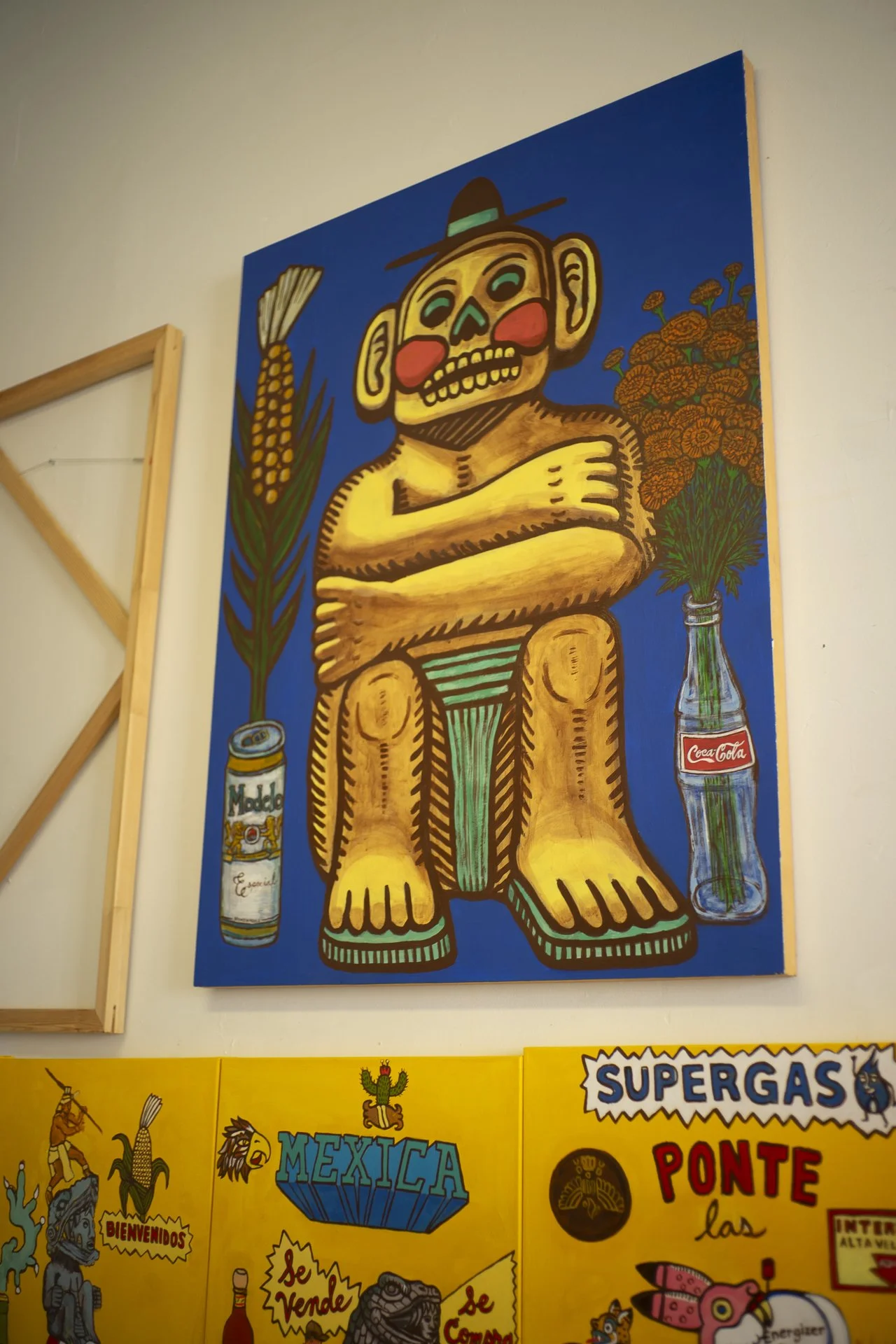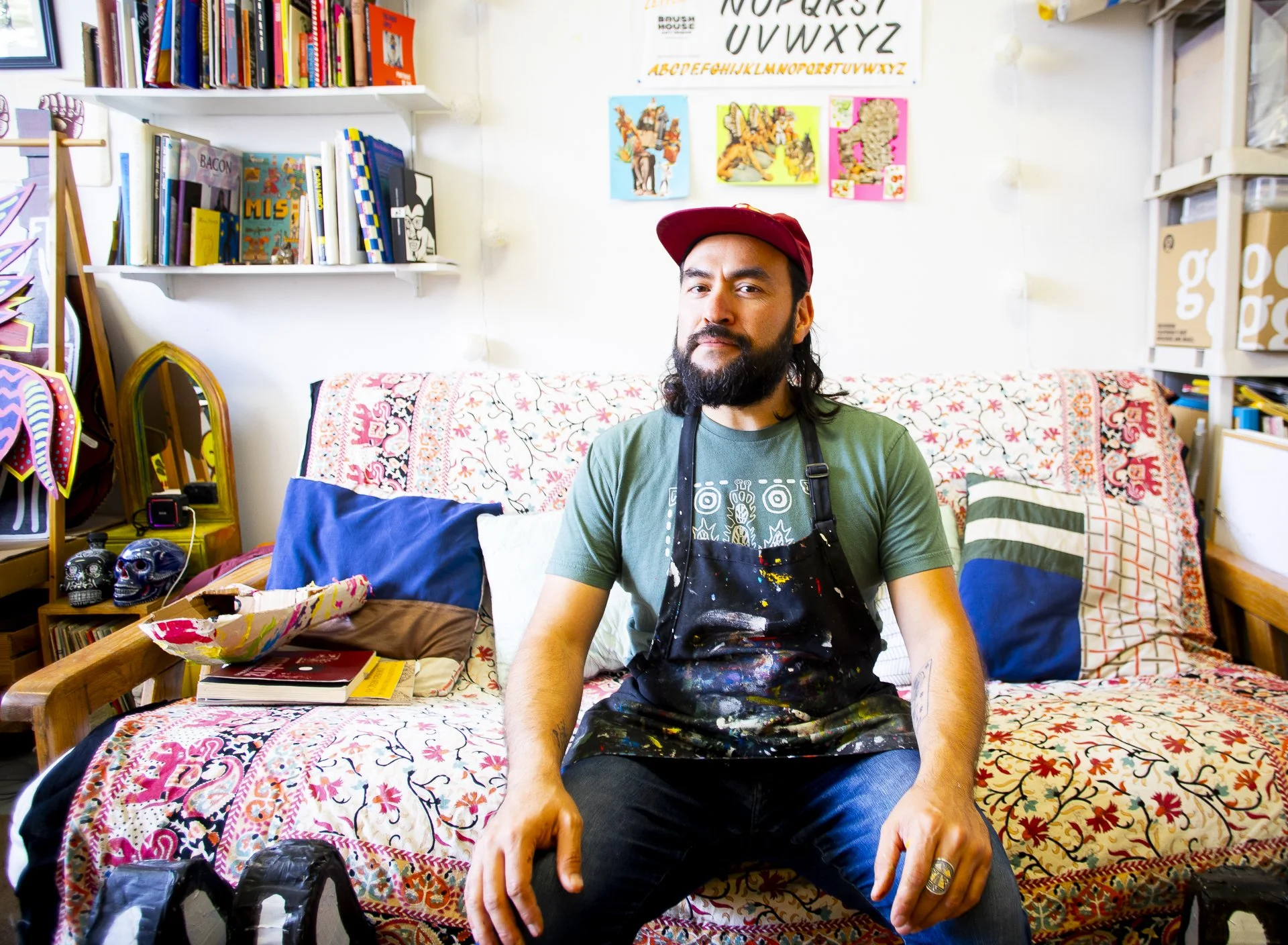Studio Visit & Interview With Rayos Magos
Interview and Photographs by Brandon Joseph Baker
I headed to San Jose on a rainy afternoon to meet with Rayos Magos in his studio before his solo show, Ancestral Download, at Moth Belly Gallery. I am not very familiar with San Jose and was excited to expand my understanding of The Bay Area through this visit. I’d done a bit of reading about Rayos, how he grew up in San Jose and thought he was an exemplary hometown local artist who could begin to shape my understanding of this area.
I was instantly struck by Rayos’ kind hospitality. His studio mirrored his personality, inviting with ample stories to tell. One wall was covered with his nearly completed series on bold bright yellow canvases with overlays of text and iconography, the output of 9 months of focused creative exploration.
Rayos describes the work as ‘a cultural patchwork influenced by contemporary Chicano and Mexican culture mixed with prehispanic Mesoamerican culture.’ The work lifts inspiration from brands, vintage ads, products, typography, coupons, comics and the Rótulos (sign painters) from Mexico. He intends for the combination of text to weave narratives or messages that one could decipher. Some are actual phrases in Spanish like “Ponte las Pilas”, which literally translates to "put in your batteries.” Rayos said this phrase is used in a metaphorical way to encourage someone to get motivated and push forward.
The volume of work in the studio speaks to Rayos’ dedication to being a full time artist while the variety of mediums tells of his excitement to create. Everywhere I point my camera I see paper mache sculptures, ink stained linocuts, an embroidered Sabertooth from X-Men, photography, journals or brightly colored collages. Despite the variety, stylistically it’s evident they are all made from the same set of curious hands.
‘I enjoy working with various mediums because I can learn the ins and outs of a material. Themes of history, narrative, culture, identity and representation are underlying a lot of the work I make,’ Rayos said of the variations in mediums he uses in his stylized studio practice.
While speaking with Rayos about his experience as an artist, observing the books on his shelves and digging into his process, I understood him to be a well-read passionate artist. The expressions and meanings in his works are personal and informed. The books he collects are art books which he uses as references and/or that he finds inspiration in. Rayos said of his current perusals, ‘Over the span of this series I have been reading about Mesoamerican groups, how they structured their societies, how they wrote and documented their belief systems. I have a linguist book that breaks down the symbols used in Nahuatl, the original language of the Mexica (Aztecs). You could say I am an anthropologist-social-psychologist-historian. I really like learning about the past as a way to understand modern times and figure out where we are headed as a society.’
I spoke to Rayos about his experience growing up in West San Jose, his sculpture installation in Palo Alto, how travel influences his perspective and how his work with the community in mental health has shaped his art practice. Through these conversations, Rayos and San Jose instantly became something I was excited to talk more about and share with others.
Interview
Thank you for meeting with me in your studio at Citadel Art Studios in San Jose. How long have you been in this studio space?
I have been in my studio at the Citadel since June of 2018. It was my first choice due to the large windows with good natural lighting. I found the space because I was working just a block away at a community mental health clinic. One day I was going on a walk with one of my clients and I saw the studio rental sign, which I called later that day. Within the next few days I had scheduled an appointment where they toured me around the warehouse showing me different spaces. The moment I saw my space I knew that was the one I wanted. So in total I have been there 7 years, where I have built a career out of my work as an artist.
What is the first thing you do when you get into the studio, do you have any rituals you like to begin working with?
Oftentimes it varies. Sometimes I light incense and walk around my space to cleanse and bring good vibes to the moment. Other times I start cleaning up the space from the previous day in order to start anew and begin a new work session. If I paused on a piece from the previous day I may jump back into it without much thought. I may eat breakfast or lunch, read or draw prior to painting/making work. I like that it is a varied set of rituals and that it’s not so rigid or serious. I feel like being flexible with the moment feels more comfortable and familiar to me.
As a mixed media artist whose work bridges multiple mediums, how would you describe your art?
I think that my work is multiversed, multilayered, multidisciplinary and introspective. I feel that a lot of my current work speaks to cultural identity and weaves a narrative about who I am and what I am fascinated by.
Another question about being an artist with command of multiple mediums, what do you enjoy most about shifting from one medium to another? Do you have a medium you prefer?
I have always been someone that gets bored easily with monotony and repetition. I tend to explore mediums through series where I can run with an idea or concept until I get bored or intuitively feel that I am done. I also feel that there are daily obstacles to creating and having a full-time studio arts practice, which lend to the shifts in changing mediums. Sometimes I am not able to return to a particular series due to travels, other pressing projects, or life tasks. Therefore, I may take an embroidery piece or linocut block that I can cut while watching television at home or that I can take with me while traveling.
I guess all in all I enjoy the fluidity of artmaking because I can play within various mediums while maintaining a certain aesthetic or subject matter. I never want to pigeonhole myself into one medium or form because I feel like I would get bored. I feel like the pure enjoyment of exploration and uncertainty is the thrill I get out of creating. It can feel scary, exhilarating, frustrating all in the same breath. Therefore, it’s the experimenting and approaching materials in this way that excites me and motivates me to continue exploring and pushing the envelope in my work.
I recently had another solo show where I gave an artist talk and one of the things I mentioned about that mixed media body of work was that I am often in competition with myself. What I mean by that is that I am always trying to one-up myself or push beyond my limits in order to grow. This may look like working on multiple pieces at once and/or working with different mediums. I am always looking to improve mainly to prove to myself that I can do it.
Most of your work is done practically, very little is digital beyond simple sketches or color tests with Procreate. Is there a driving force behind that practice?
Most of the work I do is done by hand, which ranges from initial sketches to direct creating. I use digital mock ups for composition or colorways, like you mentioned. This current series up at Moth Belly Gallery was inspired by daily morning ink sketches that I made while drinking coffee and eating breakfast. Most of the sketches were used while a few were altered digitally to change the composition. When I didn’t make sketches I used Procreate for collaging pictures together, which I later turned into paintings.
I have always been an over-thinker. Therefore, when it comes to art I take it seriously but if I overthink something that alone paralyzes my ability to create. I have learned that if I go straight for it then I tend to overcome any self doubt or fear of messing up. I quite literally dive in until I do mess up and need to pull it back. When I have gone too far in a piece I will try to rectify it, edit it, and if I cannot then I scrap the piece and try to replicate it.
What motivates you to create or where do the ideas formulate that come to life in your studio work?
I think what motivates me to create is the fact that it is the one thing that soothes me, structures my life, gives me purpose, and helps me focus. I love the ability to create something from nothing. This to me has always been a magical process. Therefore, I consider myself a magician/alchemist because I can take various materials and slap them together and make something new.
As for the formulation of ideas and how they all come together, I would say that starts from everyday life. Usually I am researching, reading, learning, and/or experiencing something in my life that is inspiring. Other times I am unable to formulate what my thoughts are verbally so I find that art literally helps me art-ticulate them (no pun intended). Everything has a beginning point, which starts from a sketch, an idea, a phrase.
I would say one of the keys to my success has been just having a sketchbook around and jotting down ideas, concepts, or sketches that I will return to at a later time. Also I find that I have a disciplined work ethic, which keeps me working and getting projects. As a full-time artist I am constantly needing to balance creating with business, research, and applying for grants, shows or awards. Most of the time I take chances that don’t pan out. However, the times I have had success it’s because I just kept going despite the odds and challenges. I feel like I have no fear of rejection because I used to overthink things and not show my artwork, not apply to art calls or grants, which was the biggest block to my success.
We talked of the inspiration gained from getting outside of your hometown of San Jose, can you elaborate on how your art has grown with traveling and artist residencies in other communities or outside of the United States?
I have always been interested in world travel since I was a child. Growing up my aunt traveled for government work and she would bring us back trinkets, foreign currency, and stories about her travels. This always inspired me and led me to wanting a similar lifestyle of travel, adventure, and stories. I think that getting out of my hometown was necessary in order for me to see, learn, and expand my horizons.
I feel that my art has grown because of traveling and seeing what other people are doing in other places. Oftentimes when I travel I take a lot of pics, videos, and bring sketchbooks with me to document what I am doing and where I am at that moment in time.
I have had some great experiences traveling that are very impressionable and have steered my art career in this direction. I feel like artist residencies in other communities have been helpful because I am able to focus on the artmaking, experiencing, and finding novelty in the place I am in.
During residencies I am looking for references and documenting my experiences via photos, sketches, and timelapse videos. If I could suggest anything to emerging artists it would be to get out of your comfort zone and travel to a new place. Apply to grants, art calls, and take workshops that expand your professionalism. I continue to learn by doing things that are uncomfortable because I know that it will stretch my capacity in a positive way.
Travel has always been the thing that pushes me to soul search and find the commonalities between cultures and people. Art to me is a universal language and connector that moves beyond spoken language.
You grew up in West San Jose, has that had an influence on your art practice? What other influences have shaped the way you create and the themes you pursue in your art?
I have never really thought about how growing up on the West side of San Jose influenced my arts practice. One way I guess that it did was through observing graffiti art. I grew up in an area that was urban and had a lot of graffiti on the main streets. In my adolescence I also got into graffiti and doing throwups, tags, and pieces. At that time I was drawing a lot in black books and doing illegal graffiti, which in the span of my lifetime was short lived due to getting caught up with a friend around 18. I think the immediacy of graffiti always appealed to me because it was raw, graphic, and emotive. Every now and then I still do some street art although I prefer my freedom and not having to pay fines for vandalism.
Other influences on my arts practice were probably my family. My pops showed me how to draw super heroes, cars, and characters when I was a kid. My parents always bought me art supplies for my birthdays, which is why I drew and made things a lot as a kid. On both sides of my family there were artists but none that did it professionally. My grandma that raised us was an artisan. She could draw, paint, make furniture, and put things back together, which also influenced my interest in art. I would also say that the Chicano culture that I grew up around also influenced me, which ranged from music, lowriders, graffiti, gangs, and street life. Interwoven in all those subcultures was the common thread of Brown pride and being proud of where you came from. I think that I have always been an observer, which allows me to be on the periphery witnessing people do their thing. I’d say that I have keen observational skills which also led me to working in Psychology as a career path.
Can you describe what it was like to leave your career in psychology as a licensed therapist to pursue your art full time? Does your background in psychology seep into your art practice?
Referring back to what I mentioned above about having good observation skills I think going into psychology was a big part of who I was, which was a good listener and observer as a kid. People would come to me for advice, which I always thought was interesting. Full circle I worked in mental health and studied how to use the arts with people.
As far as leaving my full-time career working in the mental health field I feel content with it. When I told my coworkers about it, they thought I was mad crazy and that I would quickly return to work for job security. Obviously it was a big change and a leap of faith for me to let go of a full-time career with benefits. In exchange I was signing up for a new career in art, which was full of uncertainty, instability and inconsistent pay. It was still the pandemic in 2021 and so things were still weird. I was working from home talking to my clients daily and writing reports on their progress. At a point I became burnt out and emotionally and psychologically drained from holding a lot of people’s trauma stories. Also working in the mental health field there’s a lot of bureaucracy, responsibility, liability, and lots of paperwork involved, which was the hardest part. I was over all of it and needed a break. I recognized that burn out, which looked like me avoiding in-depth conversations with loved ones, having a short attention span, and wanting to be alone for longer periods of time in my art studio was the breaking point for me.
I’d say my psychology background has influenced my artwork from how I see it, to how I want to tell narratives about certain subject matter, and also how I write about my reflections of the work I make. I also feel that when it comes to community based art projects where I need to work with community members, my skill set as a therapist comes into play. Community projects allow me to use my social skills, interviewing skills, and organizational skills in working with people.
While creating your public sculpture in Palo Alto, “Te Veo, Te Escucho, Te Honro (I see you, I hear you, I honor you)” you did a 6 month residency working with the Latinx and BIPOC community and mental health providers in Palo Alto. Can you expand on what the sculpture and the experience meant for you?
Yeah so in the year of 2022 I applied and received the first King Artist in Residency in Palo Alto. The goal of the residency was to engage the BIPOC community via community arts engagement. My project was entitled Rituals of Resilience and looked to focus on the Latinx community that lived and/or worked in the Palo Alto area.
My project goal was to understand how Latinx essential workers coped during the pandemic and what rituals they developed to maintain their mental health. My background in Psychology definitely came in hand and influenced the project focus. For 6 months I ran community based art workshops, community engagements, and interviewed Latinx essential workers. Afterwards, like a good psychologist researcher I took the qualitative data (thematic info) and searched for common threads or themes that I found while working in the community. That community feedback then translated into a symbolic sculpture full of imagery connected to the community.
The metal sculpture entitled “Te Veo, Te Esucho, Te Honro (I see you, I hear you, I honor you)” was designed based off of my project. Honestly it was one of the biggest budgeted projects that I have ever worked on. This to me signaled that I was on the right path with my art career. So all in all the project was worthwhile because I was able to get it, run it, and pull it off. I feel like it was a high achievement for me, my family and my community.
I love the bold powerful yellow you’ve used in these works, it really unifies the body of work. Is there a significance to that color choice and is this your first time using it?
Interestingly, this is not the first time that I have used this color. I first used it with the public art sculpture we talked about earlier, where I intentionally chose the color yellow. The research around the color yellow in Mesoamerican culture yielded some interesting information. I found that yellow can have both positive and negative connotations. My goal for using this series was a subconscious choice and partly because I had a gallon bucket of yellow that I used for an earlier public art project where I painted a whole utility box yellow. However, I see the color as one of enthusiasm, hope, joy, inspiration, and exaltation. I wanted to bring joy and vibrancy to the color palette and content which I was creating.
What is your take on the DIY art community in The Bay Area?
I think there is a great DIY arts community in the Bay. I feel like the only way to get out there is to do it yourself. I feel like the Bay has that hustle hard and grind mentality, which I have always learned and loved as a bigger life lesson.
Sometimes I wish more folks were aware of all the DIY arts activities that are happening in the South Bay. I feel like San Jose gets overlooked as a creative hub. Perhaps that's why I try to go as hard as I can to let people in the Bay know that San Jose is still part of the Bay and that there are some really dope artists coming out of the South Bay. All in all I am happy to be from the Bay and that there is a thriving arts community that allows me to work full-time.
What is next for you?
I have a few community art projects coming up next that I have been working on the side during this past month of trying to finish up pieces for this Moth Belly show.
These community projects bring me a lot of joy because it is for everyday folks that don’t necessarily go to art galleries or museums. I enjoy making large installations that bring people together and make them smile. I feel like this is the main reason I enjoy making art is because it has the power to alter someone’s feeling, emotion, and thought process.
After these projects are done I am packing up my life and moving out of the country to Toronto, Canada with my partner. It is a bittersweet moment in my life to say goodbye to the Bay but I know that it will always be home and that I still have family that I will return to for visits. I am really excited about what’s to come from my move to Toronto as the art scene there is burgeoning. It reminds me a lot of the Bay because it’s so diverse and has the hustle spirit.
“Ancestral Download” opens 6-9pm on October 2nd, and will be on view until November 15th at Moth Belly Gallery.
